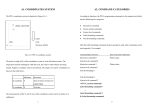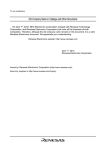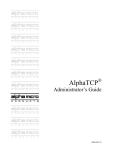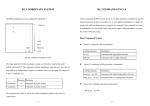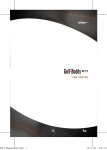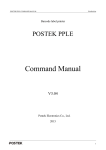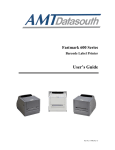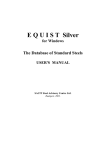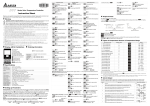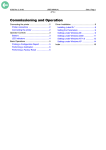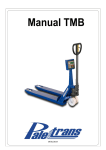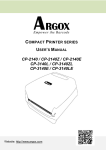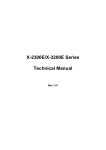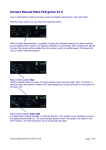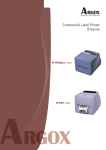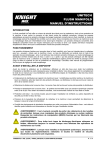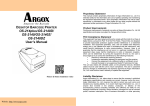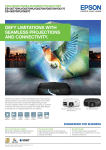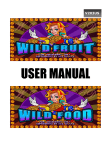Download Downloading
Transcript
TRADEMARK CREDITS
INTRODUCTION
PCL is a registered trademark of Hewlett-Packard Company.
Windows, MS-Word and MS-DOS are the registered trademarks of Microsoft
Argox label printers are featuring high resolution and rich diversity of fonts, bar codes
Corporation.
and graphics. General speaking, under Windows environment, with the bundled driver,
PC is a registered trademark of International Business Machines.
the user can already make his own desired labels by using the professional label/bar
Centronics is a registered trademark of Centronics Corporation.
code applications e.g. CodeSoft or BarTender, or using the common applications, like
CodeSoft is a registered trademark of Techniques Avancees.
MicroSoft Word, PaintBrush. And in those cases, the technical reference manual may
BarTender is a registered trademark of Seagull Scientific Systems, Inc..
not be necessary.
LabelView is a registered trademark of Techniques Avancees.
LabelMatrix is a registered trademark of StrandWare, Inc..
This manual explains all programming commands for Argox label printers. All of the
Datamax is a registered trademark of Datamax Bar Code Products Corporation.
commands except for interaction commands can be sent from the host to the printer
Eltron is a registered trademark of Eltron International Inc..
through the Centronics or Serial (RS232C) ports. Provided that the host is PC or PC
compatible, its I/O ports shall include LPT1:, LPT2:, LPT3, COM1: and COM2:, up to
TECHNICAL SUPPORT
the configuration of the host.
For technical support, please first consult with your local dealer, who is knowledgeable
To edit the command file, you may run non-document editor, e.g. PE2 and EDIT under
about the printer driver, application software as well as programming commands.
DOS, or BASIC program. All commands are easy to program except the graphic files.
(PCX, BMP and IMG formats need control codes)
© Copyright 1996 ~ 1998.
Part Number: 49.20002.001
For easy access of this programming language, please refer to the following table of
Fourth Edition: Dec, 2000
notations for some control codes.
Notation
Decimal
Hex
Remark
value
value
<SOH>
1
01H
interaction commands
The printer programming language is a software interface between the host and printer.
<STX>
2
02H
system commands
Through it, the external keyboard or the host can send data/commands to the printer to
<ACK>
6
06H
acknowledge
get the required printouts.
<LF>
10
0AH
line feed
<CR>
13
0DH
carriage return
Basically Argox printers support two kinds of printer programming
<XON>
17
11H
XON code for communication
languages/emulations. But both languages cannot function at the same time, since each
<XOFF>
19
13H
XOFF code for communication
of them has their own features and characteristics.
<NAK>
21
15H
not acknowledge
<ESC>
27
1BH
font downloading commands
PRINTER PROGRAMMING LANGUAGES
PPLA
Printer Programming Language A (PPLA) is compatible with the language on the
With these software commands you are able to
Datamax’s Printers. It supports more graphic formats and resident fonts than PPLB.
Most of the commands are independent of resolution.
♦
Change the settings
♦
Make the label controls
PPLB
♦
Interact with the printer
Printer Programming Language B (PPLB) is compatible with the language on the
♦
Format the whole label (including bar codes, texts, graphics, lines, boxes and their
Eltron’s Printers. Compared to PPLA, it has following different features:
positions)
-
Except graphic files, the commands do not contain unprintable control codes.
Set the print attributes (transparent or exclusive OR)
-
It is more suitable for stand-alone operation.
-
Its commands are dependant on resolution. All units are shown in pixels.
-
It supports binary raster data for Windows environment.
♦
The sections of A1 ~ A10 and AA ~ AD on the next page are for use of the PPLA and
B1 ~ B5 and BA ~ BE for PPLB. Check the emulation on your printer (from the LCD
display or self-test printout), then select the related sections to read.
CONTENTS OF PROGRAMMER’S MANUAL
Section A: About PPLA
A1. Coordinates System ………………………………………………. 1
A2.
Command Categories ………………..……………………………. 2
A3.
Interaction Commands ……………………………………………. 3
A4.
System Setting Commands ..……………………………………… 7
A5.
System Level Commands ……….………………………………... 14
A6.
Label Formatting Commands …………………………………….. 32
A7.
Image Editing Commands ..………………………………………. 49
A8.
Font Downloading Commands …………...………………………. 61
A9.
Programming Examples for Texts ………………………………... 63
A10. Programming Examples for Bar Codes ….………………………. 69
AA.
HEX Graphic Format ……………………...……………………… 86
AB.
How to Send the Commands to Printer .………………………….. 87
AC.
Font Selection from Font Board .…………………………………. 89
AD.
Fonts and Bar Codes For PPLA…. ………………….……………. 90
Section B: About PPLB
B1. Coordinates System ………………………………………………. 103
B2.
Command Syntax ………………………………………………… 105
B3.
Fonts ……………………………………………………………… 107
B4.
Command Set …………………………………………………….. 110
B5.
Command Reference ……………………………………………… 112
BA.
PCX Specification ………………………………………………... 169
BB.
How to Select a Font from Font Board …………………………… 172
BC.
How to Make a Form ……………………………………………... 173
BD.
Additional Commands ……………………………………………. 176
BE.
How to Send Commands to Printer ………………………….…… 178
BF
Fonts and Bar Codes For PPLB…. ………………….……………. 180
A1. COORDINATES SYSTEM
The PPLA coordinates system is depicted in Figure A1-1.
A2. COMMAND CATEGORIES
According to functions, the PPLA programming commands in this manual are divided
into the following five categories:
↑ (Blank Label Roll)
♦
Interaction commands
+y
♦
System setting commands
♦
System level commands
♦
Label formatting commands
♦
Font downloading commands
Label
(0,0)
Feed
+x →
Direction (exit)
Only the label formatting commands must be grouped to send, other commands can be
sent separately. For example:
Fig. A1-1 PPLA coordinates system
Command/data from host
Data from printer (RS232C)
Interaction command 0
Printer status
The point of origin (0,0) of this coordinates system is at the left bottom corner. The origin
System level command 0
point remains unchanged, while the texts, bar codes or other objects are being rotated.
Interaction command 1
Negative coordinate value is not allowed. The ranges of X and Y coordinates are shown
System level command 1
in the table below:
Font downloading 0
Printer status
…
X coordinate
Y coordinate
Minimum
Maximum
Font downloading N
0
about 4 inches (6 inches for
System level command 2
G6000/7000)
<STX>L (system command)
30 inches
Label formatting command 0
0
…
The measurements of the X- and Y-axis of the coordinates system can be in inches or in
Label formatting command N
millimeters.
E (Label formatting command)
1
2
A3. INTERACTION COMMANDS
Byte 1
Y - firmware parser is busy.
N - firmware parser is idling.
The interaction commands demand the printer’s immediate interaction. But the printer
only communicates a detailed status to the host via the printer’s serial (RS232C) port,
Byte 2
Y - paper out.
N - paper installed.
since only serial port supports bi-direction communication.
Byte 3
Y - ribbon out.
N - ribbon installed.
Upon receiving this kind of command, the printer will either perform the command or
send back the corresponding data to the host so that the user and programmer can
Byte 4
determine what to do with the next step.
Y - printing batch file.
N - others.
Byte 5
Y - at printing state.
N - not at printing state.
Command
Description
Response from printer
<SOH>#
Resets the Printer
<XOFF> <XON> T
Byte 6
Y - printer is paused and waiting
for the second press.
N - printer is not paused.
1.
This command resets the printer like “power on” step. Resetting the Printer returns
Byte 7
all settings to default value, except the downloaded graphics and fonts.
2.
The printer sends <XOFF>, suspending the data input.
3.
The printer sends <XON> and ‘T’, ready to resume work.
4.
Since this command will delay communication for one second, if not necessary, the
user is advised to send other alternative system level command instead of this one.
Command
Description
Response from printer
<SOH>A
Sends a readable status string
XXXXXXXX<CR>
This command drives the printer to retrieve an 8-byte data string followed by a <CR> to
the host. Each ’X’ will be ‘Y’ or ‘N’ reporting the printer status.
Y - label is present.
N – label is not present.
Byte 8
N – always ‘N’.
Command
Description
Response from printer
<SOH>B
Toggles pause condition
None
This command toggles the pause state on or off. Byte 6 generated from <SOH>A will
reflect the change of the status.
Command
Description
Response from printer
<SOH>D
Disables the interaction command. None
Interaction commands will be ignored after this command is sent.
3
4
The <SOH>D command must be sent prior to loading graphic images or fonts, since
Bit 6
some graphic images or fonts may contain data sequences that can be misinterpreted as
1 - printer is paused and waiting for
the second press.
commands by the printer.
0 - printer is not paused.
Bit 7
Command
Description
Response from printer
<SOH>E
Sends preset label to be printed
XXXX<CR>
1 - label present.
0 - label not present.
Bit 8
0 – always ‘0’.
This command drives the printer to report the numbers of labels queued to print.
This ‘XXXX’ is a 4-digit decimal number, e.g.
0020<CR>
(There are still 20 labels left in printer buffer waiting to be printed.)
Command
Description
Response from printer
<SOH>F
Sends one byte printer status
X<CR>
This command instructs the printer to send a single byte where each bit(1 or0) represents
one of the printer’s status flags, followed by a <CR>.
Bit 1
1 - firmware parser busy.
0 - firmware parser idling.
Bit 2
1 - paper out,
0 - paper installed.
Bit 3
1 - ribbon out,
0 - ribbon installed.
Bit 4
1 - printing batch file
0 - others.
Bit 5
1 - at printing state.
0 - not at printing state.
5
6
A4. SYSTEM SETTING COMMANDS
This command should comply with other settings for printer configuration. In case that
the setting is not correct, the printer may hang to work or miss-detect the gap. For
System setting commands are used to control the printer configuration and will be written
2
into the printer E PROM. This kind of commands will remain in effect, whenever the
instance, if the setting is thermal transfer and the ribbon is not installed, the printer will
stop working and blink both LEDs.
printer is turned on, unless the command of with different parameters
to replace it.
Note: This command is for OS214/314 and X1000+ only.
The factory default settings are
Command
Description
Parameter Range
**
<STX>KI8n Sets baud rate
n : ‘0’ – 9600,
Parameter Description
Default Value
Remark
‘1’ – 600, ‘2’ - 2400,
RS232 baud rate
9600 baud
**
‘3’ – 19200, ‘4’ - 4800,
Print darkness
Normal darkness (H10)
Transfer type
Thermal transfer
**
Gap length
3 ~ 5 mm (normal)
**
Cut position
Center of gap
**
Above command is used for RS232 communication. It becomes effective after the printer
Command mode
Standard control codes
**
is being restarted. This command can be sent either through the serial port or the parallel
Label length for continuous label
0.
**
port, provided that the host and the printer are under the same protocol (baud rate and
(under Windows)
From top to last black pixel.
Symbol set for ASD smooth fonts
USASCII
Cutter operation
Cut with back-feed
‘5’ – 38400, ‘6’ - 1200,
‘7’ - 9600 baud.
data format).
++
**: For the X2000+/X3000+/G6000/G7000, these settings are controlled by the DIP
Example:
<STX>KI83
The above example will set baud rate to 19200 for RS232C.
switches. No command is required.
++: Settings for X2000+/X3000+/G6000/G7000 only.
Command
Description
<STX>KI7n Sets transfer type
**
This command is not valid for X2000+/X3000+/G6000/G7000.
Parameter Range
n : ‘0’ for direct thermal or
‘1’ for thermal transfer
7
8
Above command is used to select the European symbol set. It is for the use of ASD
Command
Description
<STX>KI9bdpt Sets baud rate, data
Parameter Range
smooth font set, which is prevailing in Europe.
b : ‘0’ - 9600, ‘1’ – 600, ‘2’ - 2400,
Example:
<STX>KI<7<CR>
length, parity and
‘3’ - 19200, ‘4’ – 4800,
stop bit no.**
‘5’ - 38400, ‘6’ – 1200,
<STX>L<CR>
‘7’ - 9600.
D11<CR>
d : ‘7’ - 7-bit data, ‘8’ - 8-bit data.
191100300100020Special characters: æÆÅ<CR>
p : ‘N’ - none parity,
E<CR>
‘E’ - even parity,
Supposed you are using the Danish system and keyboard, the above command will select
‘O’ - odd parity.
Danish/Norwegian symbol set and enable the printer to print some special characters.
t : ‘1’ - 1 stop bit, ‘2’ - 2 stop bits.
Example:
<STX>KI917E1
The above example will set baud rate to 2400, bit data to 7, parity to even and stop bit to
1.
**
Command
This command is not valid for X2000+/X3000+/G6000/G7000.
Description
<STX>KX____ Sets label length for
continuous label.
Command
Description
Parameter Range
<STX>KI<m
Sets symbol set for
m : ‘0’ - USASCII,
ASD smooth fonts
Parameter Range
____ is a 4 digit decimal value in
millimeters (mm).
This command is valid for using Label Dr. driver under Windows. Without this command
‘1’ - United Kingdom,
(setting) the label length ranges from the start printing position to the last black image
‘2’ - Spanish,
(pixel).
‘3’ - Swedish,
‘4’ - French,
Example:
<STX>KX0100<CR>
‘5’ - German,
‘6’ - Italian,
Sets the continuous label length to 100 mm.
‘7’ - Danish/Norwegian.
**
This command is not for X2000+/X3000+/G6000/G7000.
9
10
Command
Description
Parameter Range
Command
Description
Parameter Range
<STX>KI0n
Sets cut mode.
n value:
‘0’ : Standard control codes.
‘0’ : mode 0, normal mode. (cut
‘1’ : Alternative control codes.
<STX>KI;n Sets control code set.
n value :
and back-feed for the next label).
‘1’ : mode 1, cut without
Refer to the list below for standard and alternative control codes. To exit from the
back-feed.
alternative mode, just reset the menu on the printer panel or send the command of
“!KI;1”.
To set to mode 1 (<stx>KI01), ensure to comply with the following conditions:
Control codes
Hexadecimal value
CR
0DH
-
The label length must exceed 1.5 inches.
-
The printer must be X2000+/X3000+/G6000/G7000.
ESC
1BH
-
The last label of a batch job cannot be cut until next label data is sent to the printer.
STX
02H
\
5CH
Parameter Range
[
5BH
— is a two digit value and in terms
!
21H
Standard (default)
Alternative
Command
Description
<STX>K15— Sets the gap height
of millimeters.
**
This command is not applicable to X2000+/X3000+/G6000/G7000.
If the gap height is more than 6 mm the command must be sent otherwise the label
detection may be incorrect.
Command
Description
Parameter Range
<ESC>KI;_
Sets offset value for
_ is a binary signed byte in
cutting or peeling
terms of pixels. 00H ~ 7FH are
position.
positive values and 80H ~ FFH are
This command is for OS214/204/202/314 PPLA only.
Example: <STX>K1508
negative values.
Sets the gap height to 8 mm.
This command set the cut position for specific labels.
**
This command is not for X2000+/X3000+/G6000/G7000.
11
12
A5. SYSTEM LEVEL COMMANDS
Command
Description
Parameter Range
This group of commands is used to set the printing related parameters or environment for
<ESC>KI:_
Sets horizontal shift.
_ is a binary signed byte and in
the current or subsequent labels. They will be reset after restarting the printer or by
terms of pixels. 00H ~ 7FH are
other related system level commands. Unlike system setting commands, these commands
positive and 80H ~ FFH are
will not be saved into EEPROM.
negative.
Command
Description
This command shifts the image print position in the X coordinate.
<STX>A
Sets date and time
**
This command sets the data and time. It takes effect only when the RTC(real time clock)
This command is for X2000+/X3000+/G6000/G7000 only..
Default
board is installed. In general the RTC board must be set at the first time you use it.
Command
Description
<ESC>@0
Clears the flash memory that is used
<STX>AwmmddyyyyhhMMjj
for soft fonts, forms or graphics.
Location
Digit no.
Description
This command clears the flash memory. All objects in the flash memory will be deleted
w
1
Day of week. 1 for Monday
after this command is sent.
mm
2
Month. 01 for January
dd
2
Day.
yyyy
4
Year.
hh
2
Hour in 24 hour format.
MM
2
Minutes.
jjj
3
Julian data.
Example:
<STX>A5100720001230287
This command sets Friday Oct. 7th, 2000, 12:30, the 287 of
the year.
13
14
automatically increase to cover the object. In consequence, it becomes 0200*N.
Command
Description
Default
<STX>a
Enables label echo character
Disabled
Make sure the object ready to be printed no longer than 30 inches, otherwise unexpected
outcome will occur.
This command enables the printer to send the control code of RS (1EH ) the host through
the serial port after each label is being printed.
Example:
Command
Description
<STX>Dxxxxxxx
Dumps the memory contents
<STX>a
; 1st label printed
1EH
nd
; 2 label printed
1EH
This command is used for debugging program or maintenance purpose only. It dumps the
memory contents for 4 K memory and sends them to the host through the RS232 port.
Parameter: xxxxxxx
Command
Description
Default
<STX>cxxxx
Sets continuous label length 0000
A 6 or7-digit HEX value used for specify internal memory address of the printer (7 digits
For models OS314/X2000+/3000/G6000/7000 and 6 digits for models
OS204/214/202/X1000+.)
This command disables the edge sensor sensing the gap or mark between the labels and
sets a page length for the printer to feed. (Otherwise the printer will feed the label for 12
Example: <STX>D9090000
inches long.)
Dump the memory from 9090000H for 4 K bytes.
Response:
This command will overwrite <STX>e and <STX>r commands, which are in conflict
9090000 00 00 00 00 00 00 00 00 00 00 00 00 00 00 00 00
with it. The label length means the distance between the start printing position to the
9090010 00 00 00 00 00 00 00 00 00 00 00 00 00 00 00 00
stop printing position.
…
…
…
9090FF0 00 00 00 00 00 00 00 00 00 00 00 00 00 00 00 00
Parameter: xxxx
4-digit decimal used to set paper length. (Maximum value: 30 inches)
Example: <STX>c0200
(set two-inch continuous label)
Provided the print object is longer than the set paper length, the paper length will
15
Command
Description
Default
<STX>Exxxx Sets copy count for stored label 0001
16
This command should be sent in conjunction with <STX>G, as both commands are
Command
related to label storage. The stored label format is the last printed format, kept in the print
<STX>fxxx Sets stop position and automatic
buffer.
Description
Default
f220
back-feed for the label stock
Example:
<STX>E0003<CR>
1.
<STX>G<CR>
This command causes the label stock to stop at a position convenient for the user to
tear off. When the next label format is sent to the printer, it will automatically
back-feed to the start of print position.
Result:
Print out 3 pieces of the last printed label format.
Command
Description
<STX>e
Selects edge sensor for gap
2.
Back-feed will not be activated if xxx is less than 220.
3.
Under multi-copy or continuous printing, this command is valid only for the first
label and last labels.
Example:
1.
This command is used for see-through media. It sets the printer to sense the gap
<STX>f320<CR>
Result: Label stock feeds backward for one inch before the next label format
is printed.
between labels.
2.
Refer to <STX>r for reflective media.
3.
Once received this command, the printer will ignore the previous command for
Command
Description
continuous label.(<STX>cxxxx).
<STX>G
Prints stored label format
This command should be used in conjunction with <STX>E.
Command
Description
The stored label format is the last printed label format kept in the buffer.
<STX>F
Feeds a label
Example:
<STX>L<CR>
121100000200100This is a label<CR>
E<CR>
1.
2.
This command will feed a label till where the gap is being detected, in case that the
<STX>E0002<CR>
paper type is set to non-continuous.
<STX>G<CR>
The media paper will be fed for certain length, when the paper type is set to
Result:
Print the label 3 times (1+2 copies).
continuous.
3.
Basically its function is same as pressing the “Feed” button.
17
18
1.
Command
Description
<STX>Imbfnn…n
Downloads the graphics file
nn…n : file name, maximum 16 characters. The file name can be accessed with label
formatting commands (Y).
2.
The file name must be same as defined.
Parameters:
3.
Refer to the appendix AA for details of the HEX format.
m : memory module. ‘A’ for RAM module, ‘B’ for flash memory module and ‘C’ for
Example:
<STX>IAFhexfile<CR>
… (HEX file)
default module (Normally, the default module is RAM module).
<STX>L<CR>
…
Remarks: Suppose you select ‘B’ flash memory and the flash module is not installed,
1Y1100001000100hexfile<CR>
the printer will automatically save the graphics into RAM.
1Y1100002000100hexfile<CR>
E<CR>
*The flash memory module is an optional item.
Result: The HEX graphics image file “hexfile” will print on the same label.
b : ’A’ - 7-bit data image file.
f : image file format. The printer supports 4 image file formats, PCX, BMP, IMG and
HEX formats. This parameter specifies graphic format type and direction.
f parameter
Image File Format
Direction
Command
Description
Default
‘B’
8-bit BMP file format
Flipped
<STX>J
Sets pause for each printed label
Normal
‘b’
8-bit BMP file format
‘I’
8-bit IMG file format
Flipped
This command will pause the printer each time after a label is printed. The printer will
‘I’
8-bit IMG file format
‘P’
8-bit PCX file format
‘p’
8-bit PCX file format
‘F’
7-bit HEX file format
resume working only after the ‘Feed’ button is pressed.
Flipped
When the printer is at pause state, the READY LED will keep blinking to alert the user
for pressing the “FEED” button (OS series) or “PAUSE” button (the X series).
19
20
INTERNAL MEMORY<CR>
Command
Description
VER: 1.0 100198<CR>
<STX>j
Cancels pause
STANDARD RAM : 524288 BYTES<CR>
EXPANSION RAM: 0 BYTES<CR>
This command cancels the pause function generated by <STX>J.
AVAILABLE RAM : 429632 BYTES<CR>
NO. OF DL SOFT FONTS : 0<CR>
Command
Description
<STX>KQ
Inquires system configuration
Command
Description
<STX>L
Enters label formatting state
This command drives the printer to send the memory configuration including standard,
expansion and available memory sizes to the host through the RS232C.
The above command switches the printer into the label-formatting mode. The printer will
process the label formatting commands until it receives the command to exit from this
Example:
mode.
<STX>KQ
In the process of the label formatting, the system level commands will be ignored.
Response from printer:
Example:
<STX>L<CR>
121100001000050THIS LABEL IS MADE BY JIMMY<CR>
E<CR>
Output from printer:
21
22
Command
Description
Default
<STX>Mxxxx
Sets maximum label length
1200
Command
Description
Default
<STX>Oxxxx Sets print start position
0220
Above command sets the maximum label length and the printer will search for gap or
mark within the specified length accordingly. The default length is 12 inches.
This command sets the offset value for start print position.
The default 0220 sets the start print position exactly below the TPH (print head) line.
Parameter: xxxx
You may change it to meet the specific label format requirements.
A 4-digit decimal. (1 to 12 inches)
This parameter will be ignored if continuous label command is sent. (<STX>cxxxx).
Example:
<STX>M0300<CR>
Command
Description
Result:
Set maximum label length to 3 inches.
<STX>P
Enters data dump mode
Command
Description
Default
This command drives the printer to dump the HEX value of the data that is transmitted to
<STX>m
Sets measurement to metric
N
the printer afterwards.
The printer will not return to normal function, unless restarted.
There are two measurements for the printer, in millimeter and in inch.
Example:
Example:
<STX>P
<STX>m
<STX>M0600
Result:
60 mm for maximum label length
Command
Description
Default
<STX>n
Sets measurement to inches
N
Example:
<STX>n
<STX>M0600
Result:
6 inches for maximum label length
23
24
Example:
Output from printer:
<STX>IAFhexfile<CR>
… (HEX file)
<STX>L<CR>
…
1Y1100001000100hexfile<CR>
E<CR>
<STX>Q<CR>
Command
Description
<STX>qn
Clears memory module
This command clears the selected memory module.
n : ‘A’ - RAM module, ‘B’ - flash memory, ‘C’ - default module.
Command
Description
<STX>Q
Clears memory
This command instructs the printer to clear both of the RAM and flash memory.
Command
Description
<STX>r
Selects reflective sensor for gap
Normally, this command is sent at the end of each job to avoid that the graphics and fonts
become accumulated up and overflow the memory.
This command selects the reflective sensor for label detection. It is used for “Black
stripe” media sensing. If the label stock is non-continuous type, refer to <STX>e for
In case of the memory full, the printer will erase the first-in graphics or fonts. To avoid
this situation and to save the data re-processing time, you are advised to send this
see-through media. Once this command is received, the previous continuous paper
command (<STX>cxxxx) will be ignored.
command at the end of a job.
Command
Description
<STX>Sn
Sets label feed rate
This command sets the rate of the feed that the printer will feed media after the image is
25
26
printed.
Parameter: n
(‘A’ to ‘K’)
A
1.0 ips
E
3.0 ips
I
5.0 ips
B
1.5 ips
F
3.5 ips
J
5.5 ips
C
2.0 ips
G
4.0 ips
K
6.0 ips
D
2.5 ips
H
4.5 ips
Printer
Speed Range
OS214/204/202
A~E
OS314
A~C
G6000/G7000/X1000+
A~G
Command
Description
X2000+/X3000+
A~K
<STX>Unncccc
Replaces the data of the specified data
Where:
Command
Description
<STX>T
Prints test pattern
nn
field number
cccc
data to be replaced
This command is used to replace the field data in a form. Other data are kept the same as
This command is used for testing the printout quality or checking the print head for
the previous ones.
debugging or maintenance purpose. Normally users do not use this command.
Example:
Example:
<STX>T
<stx>L
D11
121100000100020filed 1 data
Output from printer:
121100000400020filed 2 data
Q0001
E
Example:
27
<stx>U01NEW DATA 1
28
<stx>E0001
Command
Description
<stx>G
<STX>Wn
Inquires the graphics/fonts and memory status
The command inquires the printer of the contents of graphics/fonts/labels as well as the
Command
Description
<STX>Vn
Sets cutter and dispenser configuration
available RAM size. The printer will check its memory and response through RS232C.
Parameter:
n
‘0’: no cutter and peeler function
F : show fonts and memory status
‘1’: Enables cutter and peeler function
G : show graphics and memory status
‘4’: no cutter and peeler function
L : show stored labels and memory status
Example:
<STX>V0
; no cutter and peeler function
<STX>V1
; Enables cut operation
Example:
<STX>WG
Response with
Command
Description
IMGFILE1<CR>
<STX>v
Inquires the printer version
BMPFILE1<CR>
AVAILABLE RAM : 421632 BYTES<CR>
This command is used for maintenance purpose. It inquires the printer of the firmware
The “IMGFILE1” and “BMPFILE1” are graphics that were downloaded before.
version. The printer will response with version and date code through RS232C.
Example:
Command
<STX>v
Description
<STX>xmtn…n Releases file from memory
Response with
Label Printer with Firmware Ver. 1.0 100198<CR>
This command deletes the specific file from the specified memory module, evacuating
memory space to load other data, further to avoid memory overflow.
29
30
Parameters:
A6. LABEL FORMATTING COMMANDS
m: the memory module identification character, please refer to
<STX>I command.
t : The file type identification code.
The label formatting commands will:
‘G’ for graphics
. Set the print environment, margins, print modes, multi-copies, etc.
‘F’ for fonts
. Set cursor position and print graphics, texts, bar codes, lines and boxes
. Control the heat of the printing, label print position and user interface
n…n : file name (maximum 16 characters)
. All commands after < STX> L are interpreted as Label Formatting Commands.
Example:
<STX>IAFstar<CR>
… (HEX file)
Different from other group commands, the label formatting commands have no leading
<STX>L<CR>
control code, e.g. SOH, STX or ESC.
…
1Y1100001000100star<CR>
E<CR>
Command
Description
Default
<STX>xAGstar<CR>
:xxxx
Sets Cut by Amount
0001
Results:
This command is valid only when the cutter is installed. It allows a predetermined
. Download the graphics with file name “star”.
number of labels to be printed before a cut is made. Please refer to [cxx].
. Print the graphic image.
. Delete the “star” image file.
Example:
<STX>V1<CR>
<STX>L<CR>
131100002000050CHCK THE CUT FUNCTION<CR>
Q0010<CR>
:0003<CR>
E<CR>
Result:
31
Enable the cutter to cut after 3 labels have been printed.
32
Output from printer:
Command
Description
Default
An
Sets logic image printing mode
A1
Example 1:
This command puts the printer on logical OR operation or XOR operation, which makes
the printout more attractive.
Example 2:
Parameter: n
‘1’ for logical XOR(exclusive OR), ‘2’ for logical OR. The default mode is ‘1’.
Example 1:
<STX>L
A1<CR>
151100002000050ABC<CR>
Command
Description
Default
Cxxxx
Sets left margin
0000
151100002000050---<CR>
E
Example 2:
This command allows horizontal adjustment of the point where printing begins. Different
<STX>L<CR>
margin value makes image shift to the left or right.
A2<CR>
151100002000050ABC<CR>
151100002000050---<CR>
Parameter: xxxx
E<CR>
33
Example:
C0100
Result:
Set left margin to one inch
34
Command
Description
Default
Parameter:
cxx
Sets cut by amount
c01
w – is pixel width (‘1’ or ‘2’, default is ‘2’).
h – is pixel height ( ‘1’, ‘2’ or ‘3’, default is ‘2’).
This command is valid only when the cutter is installed. It instructs the printer to cut the
label media after the specified numbers of labels have been printed. Its function is same
Example:
STX>L<CR>
D23<CR>
as the command “:xxxx”, except only a 2 digit value can be entered.
120000002000050PIXEL SIZE FOR D23<CR>
Example:
E<CR>
<STX>V1<CR>
<STX>L<CR>
131100002000050CHCK THE CUT FUNCTION<CR>
Output:
Q0010<CR>
c03<CR>
E<CR>
Result:
Enable the cutter to cut the label media after 3 labels have been printed.
Command
Description
Default
Dwh
Sets width and height pixel size
D22
Command
Description
E
Ends the job and exit from label formatting mode
When the Printer is in label formatting mode and receives an “E” command, it will
immediately exit from the mode and will print a label based on the data that has already
Though the maximum resolution is up to the printer model, besides the smallest one, the
been received. Even if no printable data has been received, the printer will generate and
other pixel sizes can be set by this command. However, reducing the resolution may
feed a label.
cause the image pixel to be amplified and the printout get zigzagged. The minimum pixel
size set by “D11” is varied from models.
Command
Description
Models OS204/204/X2000+/1000/G6000:
0.0049 inch (0.125 mm)
G
Stores previous data to global register
Models OS314/X3000+/G7000:
0.0033 inch (0.084 mm)
<STX>Sn
Retrieves the global register contents
35
36
The command saves the previous data to global register and retrieves it to print only
Command
Description
Default
when the restore command <STX>Sn is sent. This command may be used more than one
Hxx
Sets heat value (H02~H20)
H10
time and the global registers are named in the order created, beginning with register ‘A’
and ending at register ‘Z’.
The heat value affects the darkness of the image. To get a better quality printout, some of
the factors like paper media, ribbon types (wax, semi-resin and resin) and image pattern
Parameter: n
itself etc. should also be taken into consideration.
The Name of the register ranges from ‘A’ to ‘Z’.
Example:
STX>L<CR>
Command
Description
Default
M
Toggles the mirror mode
Normal
D11<CR>
140000000800050DATA A<CR>
This command toggles the mirror mode. At mirror state the printer mirrors the following
G<CR>
field data.
140000000800050DATA B<CR>
G<CR>
Example:
50000001800000NORMAL<CR>
140000001000000<STX>SA<CR>
M<CR>
140000001300000<STX>SB<CR>
150000001400100MIRROR<CR>
140000001600000<STX>SA<CR>
M<CR>
E<CR>
150000001000000NORMAL AGAIN<CR>
Output
Output:
37
38
Command
Description
Default
Command
Description
Default
m
Sets measurement in metric
N
Qxxxx
Sets the quantity of labels Q0001
to print
There are two measurements in the printer - metric and inch.
This command is used to set the number of the labels to be printed. If the printout
Command
Description
Default
contents are same or just different in certain auto increment/decrement fields, sending this
n
Sets measurement in inch
N
command can save the communication and processing time.
Command
Description
Default
Parameter: xxxx
Pn
Sets print speed
PC
A 4-digit decimal. The default is 0001.
Example:
This command controls the print speed.
<STX>c0060<CR>
<STX>L<CR>
A
1.0 ips
E
3.0 ips
I
5.0 ips
B
1.5 ips
F
3.5 ips
J
5.5 ips
C
2.0 ips
G
4.0 ips
K
6.0 ips
D
2.5 ips
H
4.5 ips
D11<CR>
1300000002000002 COPIES<CR>
Q0002<CR>
E<CR>
Output:
Printer
Speed Range
OS214/204/202
A~E
OS314
A~C
X1000+
A~G
X2000+/X3000+
A~K
39
Command
Description
Default
Rxxxx
Sets vertical offset
R0000
40
The command sets the vertical start point to be printed. By this command the print image
Output:
can be shifted vertically.
Example:
Result:
R0100
Set 1 inch vertical offset.
Command
Description
rn…
Retrieves label data to printer buffer
smn…
Stores label data to printer buffer
Command
Description
Default
Tnn
Sets end-of-line code
TØD
The nn is represented by
HEX value
The data of the label format can be stored in the printer memory and recalled.
With ‘store’ commands, the printer will exit from label formatting mode.
Example:
<STX>L<CR>
D11<CR>
Parameter: m: name of the memory module,
T40<CR>
n … n : file name with maximum 16 characters.
130000000200100ABC@E<CR>
Example:
<STX>L<CR>
Output:
D11<CR>
130000000200100STORED LABEL<CR>
sASLAB<CR>
<STX>L<CR>
rSLAB<CR>
130000000500100TEXT 1<CR>
The above example changes the end-of-line code from <CR> to 40H(ASCII character:
E<CR>
‘@’).
41
42
Command
Description
Default
z
Changes slash zero Ø to normal 0 slash zero
Command
Description
+xx
Makes auto increment for numeric
>xx
Makes auto increment for alphanumeric
The alphanumeric fonts (font 0 to font 6) provide both normal and slash zeros (0 & 0). If
This command can increment field on each label printed to save the time used in
this kind of fonts has been selected, the default slash zero (0) is being used. This
communication and data processing between the host and the printer.
command puts the normal zero 0 in use.
Parameter: xx
Example:
<STX>L<CR>
is a 2-digit value to specify the amount to increment the field by.
D11<CR>
130000000200100NO. 0228<CR>
Example:
E<CR>
<STX>c0050<CR>
<STX>L<CR>
D11<CR>
<STX>L<CR>
130000000200100100<CR>
D11<CR>
+10<CR>
z<CR>
Q0003<CR>
130000000200100NO. 0228<CR>
E<CR>
E<CR>
Output:
Output:
43
44
Command
Description
Command
Description
-xx
Makes auto decrement for numeric
^xx
Sets count by amount
<xx
Makes auto decrement for alphanumeric
An application using incrementing or decrementing fields will occasionally require that
This command can decrement the field on each label printed to save the time use in
more than one label be printed with the same values before the field data is updated.
communication and data processing between the host and the printer.
This command can be applied in this situation, but it can only be sent once per label
format.
Parameter: xx
is a 2-digit value to specify the amount to increment the field by.
Parameter: xx
is a 2-digit value to specify the number of labels to be generated before incrementing or
Example:
decrementing fields on the label.
<STX>c0050<CR>
<STX>L<CR>
Example:
D11<CR>
<STX>c0050<CR>
130000000200100111<CR>
<STX>L<CR>
-15<CR>
D11<CR>
Q0003<CR>
130000000200020COUNT :<CR>
E<CR>
130000000200100123<CR>
-01<CR>
^02<CR>
Output:
Q0003<CR>
E<CR>
45
46
Output:
<STX>L<CR>
121100000100010<STX>TBCD GHI PQ, TU<CR>
E<CR>
Output from printer
FRI OCT 07, 00
Command
Description
<STX>T<string>
Prints date and time
This command takes effect only when the RTC board is installed. It prints current date
and time. The <string> is any set of characters A ~ Z or a ~ z.
Characters
Description
Characters
Description
A
Day of week
vw
Hour, 24 format.
BCD
Day of week name
xy
Hour, 12 format.
EF
Month number
Za
Minutes.
GH..O
Month name
bc
AM or PM
PQ
Day
def
Julian data
RSTU
Year
Example:
47
48
A7. IMAGE EDITING COMMANDS
2- reverse landscape
3- reverse portrait
4- landscape.
The following group of commands is the subset of label formatting commands. They
control the position and the scale of the image and put the image directly into the frame
<STX>L<CR>
buffer of the printer memory. All of them are led by ‘1’, ‘2’, ‘3’ ‘4’ respectively. These
D11<CR>
numbers represent the orientation or rotation direction. The image types include:
141100000800060R1 - PORTRAIT<CR>
241100002150200R2 - REV LAND<CR>
♦
Texts
- internal hard fonts and downloadable soft fonts.
341100002400217R3 - REV PORT<CR>
♦
Bar Codes
- both one and two dimension (2D) bar codes.
441100001030079R4 - LANDSCAP<CR>
♦
Graphics
- PCX, BMP, IMG and HEX format files.
E<CR>
♦
Lines
- solid lines.
♦
Boxes
- variable sizes, length and thickness.
Text
Rotation
The format is:
Rthvoooyyyyxxxx[data string]
Parameters:
R : print direction. ‘1’, ‘2’, ‘3’ or ‘4’.
t : font type. Please refer the font tables in User’s Manual
There are 4 print directions shown as figure A7-1. The leading character controls the
direction or rotation.
1- portrait
49
50
‘B’=11, .. and ‘O’=24).
t character
ooo sub font type
‘0’, ‘1’, ‘2’, ‘3’, ‘4’, ‘000’
font type
font 0 ~ font 8 respectively.
coordinate system and the Y value is the vertical offset from the origin point.
‘5’, ‘6,’, ‘7’, ‘8’
‘9’
’000’ ~ ‘007’
‘9’
yyyy : a 4-digit value for Y coordinate. The lower left corner is the origin point of the XY
’xxx’
ASD smooth fonts.
**
‘000’ : 4 points, ‘001’ : 6 points,
xxxx : a 4-digital value for X coordinate. The lower left corner is the origin point of the
‘002’ : 8 points, ‘003’ : 10 points,
XY coordinate system. The X value is the horizontal offset from the origin point.
‘004’ : 12 points,‘005’ : 14 points,
Data string: A string of printable data with maximum 255 characters in length. The data
‘006’ : 18 points.
string ends with a <CR> control code or pre-defined code by Txx command.
for PCL soft font selection.
bar code height is ignored in case of text
xxx : A 3-digit decimal represents
orientation, 1 represents for portrait
the soft font ID.
Refer to section 8.
‘:’
‘000’ ~ ‘007’
122300001000200EXAMPLEvn FOR TEXT<CR>
y coord.
Courier fonts, (ooo represents
data
height multiplier
symbol set)++
000 - Roman-8, 001 - ECMA-94,
002 - PC set,
x coord.
font
width multiplier
003 - PC set A,
004 - PC set B, 005 - Legal,
006 – Greek and 007 - Russian.
Example:
<STX>L<CR>
D11<CR>
121100001000000FONT2, H=1, V=1<CR>
Notes: **: Models OS204/OS214/OS202/X1000+/X2000+/G6000 do not support
122100001200000FONT2, H=2, V=1<CR>
121200001400000FONT2, H=1, V=2<CR>
4-point smooth font.
++
: Models OS314/X3000+/G7000 does not support Courier fonts.
191100201700000SMOOTH, 8 POINTS<CR>
191100302000000SMOOTH, 10 POINTS<CR>
h : Horizontal scale. ‘0’ through ‘9’ and ‘A’ through ‘O’ represent scale factors. (‘A’=10,
E<CR>
‘B’=11, .. and ‘O’=24).
v : Vertical scale. ‘0’ through ‘9’ and ‘A’ through ‘O’ represent scale factors. (‘A’=10,
51
52
000 : A 3-digit value that represents the bar code height.
Output:
yyyy : a 4 digit value for Y coordinate. The lower left corner is the origin of the XY
coordinate system. The Y value is the vertical offset from origin point.
xxxx : A 4-digit value for X coordinate. The lower left corner is the origin point of the
XY coordinate system. The X value is the horizontal offset from origin point.
Data string: A string of data with maximum 255 characters in length, ended by <CR> or
pre-defined EOL (end of line) code. The length of the string may be varied from the type
of the bar code.
Bar Codes
bar code height, 000 stands for default height
orientation, 1 represents for portrait
The format is:
1A5200001000200CODE 3 OF 9<CR>
y coord.
Rthvoooyyyyxxxx[data string]
x coord.
data
narrow bar width
wide bar width
Parameters:
bar code type
R : print direction. ‘1’, ‘2’, ‘3’ or ‘4’.
Example:
<STX>L<CR>
t : bar code type. The range can be ‘A’ through ‘T’ and ‘a’ through ‘z’, each character
D11<CR>
represents a bar code type and rule. Refer to section 10 for more details on bar codes.
1A0000000200000BC 1<CR>
1A0000500200120BC 2<CR>
h : ‘0’ through ‘9’ and ‘A’ through ‘O’ represent the width of wide bar. (‘A’=10,
1A6300000200240BC 3<CR>
‘B’=11, .. and ‘O’=24).
E<CR>
v : ‘0’ through ‘9’ and ‘A’ through ‘O’ represent the width of narrow bar. (‘A’=10,
‘B’=11, .. and ‘O’=24).
53
54
Output:
ignored
line with 3-digit width and height
1X1100001000200L200030<CR>
y coord.
x coord.
line height
line width
ignored
line or box
Example:
Line
<STX>L<CR>
D11<CR>
1X1100000200000L100020<CR>
The format is:
1X1100000800000l00100100<CR>
E<CR>
RX11000yyyyxxxxLaaabbb or RX11000yyyyxxxxlaaaabbbb
Output:
Parameters:
R : print direction. ‘1’, ‘2’, ‘3’ or ‘4’.
yyyy : A 4-digit value for Y coordinate. The lower left corner is the origin point of the
XY coordinate system. The Y value is the vertical offset from origin point.
xxxx : A 4-digit value for X coordinate. The lower left corner is the origin of the XY
coordinate system. The X value is the horizontal offset from origin point.
aaa or aaaa : A 3 or 4-digit value that specifies the width of line.
bbb or bbbb : A 3 or 4-digit value that specifies the height of line.
55
56
Box
box with 3-digit width, height and side thickness
ignored
1X1100001000200B200030002003<CR>
The format is:
y coord.
RX11000yyyyxxxxBaaabbbtttsss or RX11000yyyyxxxxbaaaabbbbttttssss
x coord.
Parameters:
Example:
R : print direction. ‘1’, ‘2’, ‘3’ or ‘4’.
thickness of side edges
thickness of top and bottom
ignored
box height
line or box
box width
<STX>L<CR>
D11<CR>
yyyy : Y coordinate. A 4-digital decimal. The lower left corner is the origin of the XY
1X1100000200100B100040002005<CR>
coordinate system. The Y value is the vertical offset from origin.
1X1100000800100b0250010000030004<CR>
E<CR>
xxxx : X coordinate. A 4-digital decimal. The lower left corner is the origin of the XY
coordinate system. The X value is the horizontal offset from origin.
Output:
aaa or aaaa : A 3 or 4-digit value that specifies the width of box.
bbb or bbbb : A 3 or 4-digit value that specifies the height of box.
ttt or tttt : A 3 or 4-digit value that specifies the thickness of top and bottom box edges.
sss or ssss : A 3 or 4-digit value that specifies the thickness of side edges.
57
58
Graphic
8020FF00FF00FF00FF00FF00FF00FF00FF00FF00FF00FF00FF00FF00FF00FF00FF00<CR>
8020FF00FF00FF00FF00FF00FF00FF00FF00FF00FF00FF00FF00FF00FF00FF00FF00<CR>
Before sending the graphic selection command, make sure that the graphic was already
0000FF10<CR>
loaded into the flash memory, otherwise send the command led by <STX>I to download
8020FFFFFF0000000000000000000000000000000000000000000000000000FFFFFF<CR>
the graphic first.
FFFF<CR>
The format is:
<STX>L<CR>
D11<CR>
1Y11000yyyyxxxxn..n
1Y1100001000050HEXFILE<CR>
E<CR>
Parameters:
Output:
yyyy : A 4-digit value for Y coordinate. The lower left corner is the origin point of the
XY coordinate system. The Y value is the vertical offset from origin point.
xxxx : A 4-digit value for X coordinate. The lower left corner is the origin point of the
XY coordinate system. The X value is the horizontal offset from origin point.
n..n : graphic file name that was downloaded. (maximum 16 characters)
Example:
<STX>IAFHEXFILE<CR>
802000FF00FF00FF00FF00FF00FF00FF00FF00FF00FF00FF00FF00FF00FF00FF00FF<CR>
802000FF00FF00FF00FF00FF00FF00FF00FF00FF00FF00FF00FF00FF00FF00FF00FF<CR>
802000FF00FF00FF00FF00FF00FF00FF00FF00FF00FF00FF00FF00FF00FF00FF00FF<CR>
802000FF00FF00FF00FF00FF00FF00FF00FF00FF00FF00FF00FF00FF00FF00FF00FF<CR>
8020FF00FF00FF00FF00FF00FF00FF00FF00FF00FF00FF00FF00FF00FF00FF00FF00<CR>
8020FF00FF00FF00FF00FF00FF00FF00FF00FF00FF00FF00FF00FF00FF00FF00FF00<CR>
59
60
A8. FONT DOWNLOADING COMMANDS
This example downloads a PCL soft font with ID 100, then select it to print it.
The following commands are used for downloading the soft fonts with the PCL bitmap
format. Refer to the PCL technical manual for their descriptions. (PCL4 or PCL5).
Command
Description
<ESC>*c###D
Assigns the soft fonts ID number (### : 0 ~ 999)
<ESC>)s###W
Downloads font descriptor (### : length of
font descriptor)
<ESC>*c###E
Sets character code (### : 1 ~ 255)
<ESC>(s###W
Downloads character descriptor and image
(### : length of character descriptor and image)
For more information on the soft font format, please refer to the related PCL technical
manual.
Example:
<ESC>*c100D
<ESC>)s26W ...
<ESC>*c33E
<ESC>(s32W ...
. . .
. . .
<STX>L
190010002000200THIS IS A TEST FOR PCL SOFT FONT.
E
61
62
A9. PROGRAMMING EXAMPLES FOR TEXTS
Font 2:
This section explains how to select the internal fonts to format the desired printout and
This is a USASCII and extension set.
Example:
generate the font styles as well as font characteristics. Please refer to the User’s Manual
for the symbol table of each font.
120000000600000Font 2 : ASCII+Extension Character Set<CR>
Font 0:
This is a USASCII set from code 21H to 7FH.
Example:
100000000200000Font 0 : ASCII Character Set<CR>
Font 3:
This font includes numeric and uppercase letters
Example:
Font 1:
This is a USASCII and extension set.
130000000900000Font 3 : Alphanumeric Uppercase font<CR>
Example:
110000000400000Font 1 : ASCII+Extension Character Set<CR>
Font 4:
This font includes numeric and uppercase letters
Example:
140000001200000Font 4 : Alphanumeric Uppercase font<CR>
63
64
Font 7:
This font includes OCR-A ASCII characters.
Example: 170000001500000Font 7 : OCR-A font<CR>
Font 5:
This font includes numeric and uppercase letters
Example:
150000001600000Font 5 : Alphanumeric Uppercase font<CR>
Font 8:
This font includes numeric and some special characters only. It is an OCR-B
set.
Example: 170000002000000Font 8 : OCR-B font<CR>
1800000020002000123456789<><CR>
Font 6:
This font includes numeric and uppercase letters
Example: 160000001000000Font 6 : Alphanumeric<CR>
160000000500000
Uppercase font<CR>
ASD smooth font Set
The smooth font set includes USASCII and the extension characters with multiple point
sizes. The font type is ‘9’ for a smooth font and the height field represents the point size.
65
66
Example: 190000100400000ASD : 6 Points. ABCabc<CR>
Height
Symbol set
190000200600000ASD : 8 Points. ABCabc<CR>
000
Roman 8
190000300800000ASD : 10 Points. ABCabc<CR>
001
ECMA 94
190000401100000ASD : 12 Points. ABCabc<CR>
002
PC
190000501500000ASD : 14 Points. ABCabc<CR>
003
PC-A
190000601900000ASD : 18 Points. ABCabc<CR>
004
PC-B
005
Legal
006
PC437 (Greek)
007
Russian
Example: 1:0000000200000Courier : Roman 8 : [\]^{|}~<CR>
1:0000100500000Courier : ECMA-94 : [\]^{|}~<CR>
1:0000200800000Courier : PC : <03H><04H><05H>[\]^<CR>
1:0000501100000Courier : Legal
: [\]^{|}~<CR>
1:0000601400000Courier : PC 437 (GREEK)<CR>
Courier Fonts
The Courier font includes 7 symbol sets with 15 points. It is for models OS204/
OS214/X2000+ only. The font type is ‘:’ and the height field represents the symbol set.
67
68
A10. PROGRAMMING EXAMPLES
FOR BAR CODES
Length
Check sum Type for
readable string
Type for
Valid
non-readable
codes
Bar ratio
string
This printer supports 22 bar code types, including 20 of one dimension and 2 of two
12 digits yes
dimension bar codes. The functions of parameters are varied from the specific bar codes.
(11+1)
’B’
’b’
0~9
2:3:4
The bar code cannot be printed out, if the input code is invalid or its length is not up to
the specification.
Example: 130000002000000BAR CODE B : UPC-A<CR>
1B000000180015502281234567<CR>
Bar code A: Code 3 of 9
Length Check
sum
Type for
Valid
Type for
readable string non-readable
Bar ratio
codes
string
variable no
’A’
’a’
0 ~ 9, A ~ Z,
2:1~
$%*+-./ and space 3 : 1
Example: 130000001320000BAR CODE A : 3 OF 9<CR>
Bar code C: UPC-E
Length
1A300000080010519450228<CR>
Check
Type for readable Type for
Valid
Bar
sum
string
codes
ratio
0~9
2:3:4
Non-readable
string
7 digits
yes
’C’
’c’
(6+1)
Example: 130000001000000BAR CODE C : UPC-E<CR>
1C0005000800160654321<CR>
Bar code B: UPC-A
69
70
The default code subset is B. To select subset A, place an ASCII ‘A’ (decimal 65 or hex
41) before the data to be encoded. To select subset C, place an ASCII ‘C’(DEC67,
HEX43) before the data to be encoded. Subset C can only encode numeric data with
even byte count.
Length Check
Bar code D: Interleaved 2 of 5 (I25)
sum
Length Check
sum
Type for readable Type for
Valid
string
Codes
non-readable
Type for readable Type for
Valid
Bar
string
codes
ratio
from code 0 to
2:3:4
non-readable
string
Bar ratio
variable yes
’E’
’e’
127 (128 codes)
string
variable no
’D’
’d’
0~9
2:1~3:1
Example: 130000001100000BAR CODE E :<CR>
The digit count should be an even number otherwise a ‘0’ will be automatically entered at
130004000900000CODE 128<CR>
the first position.
1E0004000800140TO JIMMY<CR>
Example: 130000002200000BAR CODE D :<CR>
130000002000000INTERLEAVED 2 of 5<CR>
1D5308001800170135792468<CR>
The following example will print “24681357” by Code 128 subset C.
1E0004000800160C24681357
Bar code E: Code 128 including subset A, B and C
71
Bar code F: EAN-13
72
Length
Check
Type for readable Type for
Valid
Bar
sum
string
codes
ratio
0~9
2:3:4
non-readable
string
13 digits
yes
’F’
’f’
(12+1)
Example: 130000002060000BAR CODE F : EAN-13<CR>
Bar code H: HBIC
1F0005001800160135792468228<CR>
Health Industry Bar Code (HBIC) is same as bar code A (code 3 of 9), except that it
includes an additional modulo 43 checksum.
Length Check
sum
Type for readable Type for
Valid
Bar
string
codes
ratio
0 ~ 9, A ~ Z,
2:1~
string
Bar code G: EAN-8
variable Yes
Length Check
sum
8 digits yes
non-readable
’H’
’h’
$%*+-./ and space 3 : 1
Type for readable Type for non-readable Valid Bar
string
string
codes ratio
’G’
’g’
0~9
2:3:4
Example: 130000002400000BAR CODE H : HBIC<CR>
1H0000001800120HEALTH<CR>
(7+1)
Example: 130000001100000BAR CODE G : EAN-8<CR>
1G30000008001600228001<CR>
Bar code I: Coda bar
73
74
Length
Check
Type for
Type for
sum
readable string non-readable
Valid
Bar
codes
ratio
Example: 130000002100000BAR CODE J : I25<CR>
130000001900000WITH CHECKSUM<CR>
1J000000180016019970701<CR>
string
at least 3
No
’I’
’i’
characters
0 ~ 9, A ~ D,
2:1~
$+-. And /
3:1
Example: 130000000900000BAR CODE I : <CR>
130000001100000CODA BAR<CR>
1I0000000800090ABCD0123456789<CR>
Bar code K: Plessey
An additional checksum will be added to the bar code string where ‘+’ character is
inserted.
Length Check
Bar code J: Interleaved 2 of 5 with a modulo 10 checksum
sum
Type for readable Type for
Valid
Bar
string
codes
ratio
0~9
2:1~
non-readable
string
Same as bar code D (Interleaved 2 of 5), except that it includes an additional modulo 10
checksum.
Length Check
sum
Yes
’K’
’k’
digits
Type for readable Type for
Valid
Bar
string
codes
ratio
0~9
2:1~
non-readable
string
Variable Yes
1 ~ 14
’J’
’j’
3:1
Example: 130000001100000BAR CODE K :<CR>
130000000900000PLESSEY<CR>
1K000000080012050381978<CR>
3:1
75
76
Length Check
sum
Type for
Valid
Type for
readable string non-readable
Bar ratio
codes
string
2 digits
Bar code L: Interleaved 2 of 5 with a modulo 10 checksum and shipping bearer bars
No
’M’
’m’
0~9
2:3:4
Example: 130000000900000BAR CODE M : UPC2<CR>
1M000500060016038<CR>
Same as bar code D (Interleaved 2 of 5) except that it includes a modulo 10 checksum
and the horizontal shipping bearer bars.
Length Check
sum
Variable Yes
Type for
Type for
Valid
Bar
readable string non-readable string codes
ratio
’L’
2:1~3:1
’l’
0~9
Bar code N: UPC5
The horizontal bearer bars exist only when the input digit count is 13.
Length Check
Example: 130000002300000BAR CODE L : I25<CR>
sum
Type for
readable string non-readable
130000002100000WITH CHECKSUM &<CR>
130000001900000BEARER<CR>
Valid
Type for
Bar ratio
codes
string
5 digits No
’N’
’n’
0~9
2:3:4
1L00060018001401997070187391<CR>
Example: 130000002000000BAR CODE N : UPC5<CR>
1N000500180016002280<CR>
Bar code M: UPC2
77
78
Length
Check sum
Type for readable Type for
Valid
string
codes
Non-readable
string
Variable
Yes
’p’
Not defined
0~9
Example: 130000002100000BAR CODE P :<CR>
Bar code O: Code 93
130000001900000POSTNET<CR>
1p0006001800120199707<CR>
Length Check
sum
Type for
Valid codes
Type for
Bar
ratio
readable string non-readable
string
Variable Yes
’O’
’o’
0 ~ 9, A ~ Z,
2:3:4
$%+-./ and space
Example: 130000001100000BAR CODE O :<CR>
Bar code Q: UCC/EAN Code 128
130000000900000CODE 93<CR>
1O0000000800120CODE 93 OK<CR>
Length
Check Type for
sum
Valid
Type for
readable string non-readable
Bar ratio
codes
string
20 digits Yes
’Q’
’q’
0~9
2:3:4
(19+1)
Example: 130000001300000BAR CODE Q<CR>
130000001100000: UCC/EAN<CR>
130000000900000128<CR>
1Q00070010000857812989089990899998<CR>
Bar code P: Postnet
79
80
Bar code T: Telepen
Length Check
sum
Type for
Valid
Type for
readable string non-readable
Bar ratio
codes
string
Variable Yes
Bar code R: UCC/EAN Code 128 K-MART
’T’
’t’
From 0 to 127
2:3:4
Example: 130000000900000BAR CODE T :<CR>
130000000700000TELEPEN<CR>
Length
Check
Type for
Type for
sum
readable string non-readable
Valid
Bar ratio
1T0005000600120ABC!-=.<CR>
codes
string
18 digits
yes
’R’
’r’
0~9
2:3:4
Example: 130000002300000BAR CODE R<CR>
130000002100000: UCC/EAN<CR>
130000001900000128 K<CR>
1R0006002000083199707011945022800<CR>
Bar code V: FIM (Facing Identification Mark)
Length
Check sum Type for readable Type for
string
non-readable
Valid
codes
string
1 character No
’v’
Not defined
Example: 130000000900000BAR CODE V :<CR>
130000000700000FIM<CR>
1v0000000600160B<CR>
81
82
A, B, C and D
Bar code Z: PDF-417
This is a two dimensional bar code defined by AIM International. It applies the
Reed-Solomon encoding rule and includes all ASCII characters. It provides the function
of multiple-level error detection and correction. The bar code’s data stream consists of 6
different sections:
Bar code U: UPS MaxiCode
This is a two dimensional bar code defined by UPS and AIM International. It applies the
Length
Description
1
F : normal, T : truncated
1
0 ~ 8 : security level
2
00 ~ 99 : aspect ratio, 00 stands for
Reed-Solomon encoding rule. The bar code’s data stream consists of 5 different sections:
- a 5-digit primary zip code
1:2
- a 4-digit secondary zip code
- a 3-digit country code
- a 3-digit class of service code
2
03 ~ 90 : row number, 00 for best fit
2
01 ~ 30 : column number, 00 for best
fit
- a data string that can not exceed 84 characters
Variable
Data string
Example: 130000002100000BAR CODE U :<CR>
130000001900000MAXICODE<CR>
1u0000001500160329874444840555TO JIMMY<CR>
Example: 130000002100000BAR CODE Z :<CR>
130000001900000PDF-417<CR>
1z4900001800140F0001002ARGOXINFO<CR>
Bar code W: DataMatrix
83
84
The Datamatrix is a two dimensional bar code too.
APPENDIX AA: HEX GRAPHIC FORMAT
Command for DataMatrix
Unlike the PCX, BMP and IMG formats, the HEX format is a proprietary one.
1 W 1c c d eee ffff gggg 200 0 jjj kkk ddddddddd...dd
1 W 1c : They are fixed data for DataMatrix. Do not change them.
c : horizontal multiplier for module size
d : vertical
multiplier for module size
eee : always 000
ffff : Y coordinate
gggg : X coordinate
200 0 : Constant
jjj : A 3 digit even number (or 000) of rows requested.
000 causes rows to be automatically determined.
kkk : A 3 digit even number (or 000) of columns requested.
000 causes columns to be automatically determined.
ddddd...dd : data to be encoded and printed.
It consists of 3 types of records.
Record type Format
Description
Data
xx : hex value, stands for byte count.
80xx[…]
[…] : image data, 2 hex digits represent one byte
raster image.
Repeat
0000FFxx
xx: repeat count. The repeated data will appear
at the subsequent data record. The maximum value
is 255 (FFH). If the actual repeat count is more
Example:
than 255, split it to fit the range.
1W1c23000005000312000000000DATA MATRIX
End
FFFF
End the HEX file
Encode the data "DATA MATRIX".
horizontal multiplier: 2, vertical multiplier: 3
Y coordinate : 50,
X coordinate : 31
85
86
APPENDIX AB: HOW TO SEND THE COMMANDS TO
PRINTER
1
' Continuous label(2 inches), direct thermal
2
' Print a bar code and text string
3
' 2 copies
5
PRINT "A TEST FOR COM PORT"
The way to send a command file edited under MS-DOS in PC system is subject to your
10
OPEN "COM1:9600,N,8,1" FOR RANDOM AS #1
environment:
20
PRINT #1, CHR$(2) + "KI7" + CHR$(0) ' for direct thermal
30
' CHR$(2) + "KI7" + CHR$(1) : for thermal transfer
40
PRINT #1, CHR$(2) + "c0200"
55
PRINT #1, CHR$(2) + "L"
- Set the baud rate and data format (the default baud rate under DOS is 2400)
60
PRINT #1, "D11"
- Copy the command file to COM1 port
70
PRINT #1, "1A5200000400095ARGOX"
80
PRINT #1, "131100000050030THIS IS A TEST FOR SERIAL PORT."
>MODE COM1:9600,N,8,1,P
85
PRINT #1, "Q0002"
>COPY/B CMDFILE COM1:
90
PRINT #1, "E"
1. Suppose you connect the serial cable to COM1:
' continuous, 2-inch height
' Resolution
' Copy count
' FEED
100 END
2. Suppose you connect the Centronics cable to LPT1:
- Just copy the command file to LPT1: port
>COPY/B CMDFILE LPT1:
3. Suppose you connect the serial cable to COM1: and use Quick Basic
- Open a device file and set related parameters
- Run the Basic program
Basic example program:
87
88
' Bar code A: C39
APPENDIX AC: FONT SELECTION FROM FONT
BOARD
APPENDIX AD: FONTS AND BAR CODES FOR PPLA
The special font board is used for special font styles or different language like Chinese.
And the commands for extension fonts are similar to those of standard fonts (font 0 ~ font
9).
The font type is ‘;’ and the sub font (barcode height) field represents its order in font
ROM.
Example:
1;1100201000200THIS IS FONT 2 IN FONT BOARD
The above command specifies
‘1’ - portrait orientation.
‘;’ - selects font from font board.
‘11’ - both width multiplier and height multiplier are 1.
‘002’ - font order.
‘0100’ - Y coordinate.
‘0200’ - X coordinate.
89
90
91
92
10 points
93
94
95
96
PC-B
Greek
Legal
Russian
97
98
Internal Bar Codes
This PPLA supports 20 one dimensional bar codes and 2 two dimensional bar codes.
99
100
101
102
B1. COORDINATE SYSTEM
The measurements of the X- and Y-axis of the coordinates system are by pixels or
scanned lines.
The PPLB coordinates system is depicted in Figure B1-1.
TPH Line
↑
+y
Label
Feed
(0,0)
← +x
Direction
(exit)
Fig. B1-1 Default Coordinate system
The origin point (0,0) of the coordinates system is at the bottom right corner under
default condition (ZT). The origin point remains unchanged, while the texts, bar codes or
other objects are being rotated. Negative coordinate value is not accepted. The ranges of
X and Y coordinates are:
Minimum Maximum
X coordinate
0
811 (for 203 DPI models), or 1299 (for 300 DPI
models) around 4 inches
Y coordinate
0
8728(43 inches for 203 DPI models, or 30 inches
for 300 DPI models).
103
104
B2. COMMAND SYNTAX
String
This printer language uses data string under the following conditions.
All the commands of PPLB consist of one or two alpha characters to identify the specific
function and some of them may require one or more additional parameters to supply the
Name
for graphics, soft fonts and forms
printer with sufficient information to complete the command. Each command line must be
Data
for fonts and barcodes
terminated with a LF (0AH) control code and no space is allowed within it, except in the
Prompt
An ASCII text that can be transmitted to the KDU
section of the data string.
(Keyboard Device Unit) or LCD display for X series.
Basic Command Syntax
The data string is led and ended by the character (“). The back slash character (\)
designates that the character following is a literal and will encode into the data field.
Syntax I: commands with no parameters
Refer to the following examples:
Leading characters
Description
To print
A<LF>
Command with single alpha character
“
\“
AB<LF>
Command with two alpha characters
\
\\
Syntax II: commands with fixed number of parameters
Enter into Data Field
Notes:
1.
The printer ignores <CR> and ctrl-Z (1AH) control codes. Many non
Leading characters
Description
-document editors on PC based system send CR and LF when the enter key is
Ap1,p2,p3,…,pn<LF>
Command with single leading alpha character
pressed. The carriage return (CR) code cannot be used in place of LF.
ABp1,p2,p3,…,pn<LF> Command with two leading alpha characters
2.
All commands and alpha character command, parameters are case sensitive.
Syntax III: commands with optional parameters
A[p1,p2,p3,…,pn]<LF>
105
106
B3. FONTS
The advantages of using soft fonts:
This printer language defines three types of fonts according to their stored media.
Save memory space (Graphics occupies more memory.)
Have better performance (They can be called repeatedly.)
Enable the Auto increment and decrement function
Internal Fonts
Same as internal fonts, they can be scaled, rotated or reversed.
Soft Fonts
They can be saved into either RAM or flash memory (permanent memory).
Cartridge Fonts
They can be deleted, if no use or the memory space is full.
Internal Fonts
You can download the numbers of characters as many as you need.
Each soft font also has a unique ID number. By the ID number, the soft font can be
Five internal fonts are resident in the printer’s ROM and each of them has a unique ID
downloaded, selected or deleted.
number. Different from the soft fonts, these fonts cannot be deleted.
The soft font ID number may range from A to Z.
ID number
Font Size
Remark
Cartridge Fonts
1
20 pitches, 6 points.
2
17 pitches, 7 points.
3
14.5 pitches, 10 points.
The font board or font cartridge is an optional item. The ID numbers reserved for
4
13 pitches, 12 points.
extension cartridge fonts are 7 ~ 10. 7 and 8 are for Chinese fonts, 9 and 10 for Korean
5
5.6 pitches, 24 points.
Upper case characters only
fonts.
Symbol Set
Soft Fonts
The soft fonts can be downloaded from the host by means of some utility or application
software. Once the internal fonts cannot fulfill your requirements, soft fonts may be good
The code map (table) can be redefined to another symbol set or code page. Please refer to
the user’s manual for the code tables, defined by this printer language.
solutions.
107
108
B4. COMMAND SET
8-bit Character
Symbol sets
7-bit Character
Code page 437,
USASCII, British,
Code page 850,
Danish, French,
The PPLB command sets can be categorized into the following four groups, according to
Code page 852,
German, Italian,
functions and memory allocations.
Code page 860,
Spanish, Swedish and
Code page 863 and
Swiss
Code page 865.
Setting commands
Label formatting commands
Interaction commands (through RS232)
Objet Downloading commands
Quick Reference
Command
Description
Command
Description
A
Prints Text
N
Clear Frame Buffer
B
Prints Bar Code
O
Select Options**
b
Prints 2D Bar Code
P
Print Label
C
Counter
PA
Print Automatic
D
Heat Setting**
Q
Set Label and Gap
Length**
109
EI
Prints Soft Font Names
q
Set Label Width**
EK
Deletes Soft Font
R
Set Origin Point**
ES
Downloads Soft Font
S
Set Print Speed**
FE
Ends Form Store
TD
Define Date Layout
FI
Prints Form Names
TS
Set Real Time Clock
FK
Deletes Form
TT
Define Time Layout
FR
Executes Form
U
Print Configuration
FS
Saves Form
UN
Disable Error Report
110
GG
Prints Graphics
US
Enable Error Report
GI
Prints Graphic List
V
Define Variable
GK
Deletes Graphics
X
Draw Box
GM
Stores Graphics
Y
Setup Serial Port++
GW
Prints Immediate Graphics
Z
Set Print Direction
**
I
Selects Symbol Set
ZS
Enable Store-to-Flash
JB
Disables Back Feed**
ZN
Disable Store-to-Flash
JF
Enables Back Feed**
?
Download Variables
LE
Lines Draw by Exclusive
d
Horizontal Shift
LO
Lines Draw by OR
LW
Draws White Line
B5. COMMAND REFERENCE
This section lists all of the commands and their descriptions in alphabetical order.
A
Syntax
Prints Text
Ap1,p2,p3,p4,p5,p6,p7,”DATA”↵
Ap1,p2,p3,p4,p5,p6,p7,Cn↵
Ap1,p2,p3,p4,p5,p6,p7,Vn↵
Ap1,p2,p3,p4,p5,p6,p7,”DATA”Cn ↵
Ap1,p2,p3,p4,p5,p6,p7,”DATA”Vn ↵
Notes:
**
The parameter can be saved into permanent memory E2PROM, that is, it will
Description
Prints a text string, counter or variable.
Parameters
p1: X coordinate in dots.
remain after the printer is restarted, until it is replaced by different parameter
through command.
++
The command is not valid for X series.
p2: Y coordinate in dots.
p3: Orientation or Print Direction.
p3 value
Description
0
No rotation (portrait)
1
90o rotation
2
180o rotation
3
270o rotation
p4: ID number for font selection
p4 value
1~5
Description
Selects resident fonts, font number 1 ~ 5. Refer
to the startup self-test printout to see the font
list.
111
112
A~Z
Downloaded soft fonts, A ~ Z. Before selecting
Notes :
a soft font, first download it.
1.
All PPLB samples in this manual are printed from the 300 DPI printers.
2.
The sub-string of counter and variable can be applied to the A command.
p5: Horizontal scale factor.
p6: Vertical scale factor.
Syntax
The acceptable values for both p5 and p6 are from 1 to 24.
Vn[st,len]
Cn[st,len]
p7: N for normal text or R for reverse text image.
Where :
n is the counter or variable ID.
“DATA”: A text string
st is the start location (the first location is 0),
Cn: A counter value. Refer to C command.
len is the length of the sub-string.
Vn: A variable string. Refer to V command.
Example
Example
V00[0,3]
; A sub-string of variable 0, starting from 0 and length is 3.
N↵
A50,30,0,1,1,1,N,"This is font 1." ↵
A50,70,0,2,1,1,N,"This is font 2." ↵
A50,110,0,3,1,1,N,"This is font 3." ↵
A50,150,0,4,1,1,N,"This is font 4." ↵
A50,200,0,5,1,1,R,"FONT 5"↵
P1↵
Output
113
114
B
Prints Bar Code
2M
Matrix 2 of 5
2U
UPC Interleaved 2 of 5
3
Syntax
Bp1,p2,p3,p4,p5,p6,p7,p8,”DATA”↵
3C
Code 3 of 9
Code 3 of 9 with check sum digit
Bp1,p2,p3,p4,p5,p6,p7,p8,Cn↵
9
Code 93
Bp1,p2,p3,p4,p5,p6,p7,p8,Vn↵
E30
EAN-13
Bp1,p2,p3,p4,p5,p6,p7,p8,”DATA”Cn ↵
E32
EAN-13 2 digit add-on
Bp1,p2,p3,p4,p5,p6,p7,p8,”DATA”Vn ↵
E35
EAN-13 5 digit add-on
E80
EAN-8
E82
EAN-8 2 digit add-on
E85
EAN-8 5 digit add-on
Description
Prints a specific bar code.
Parameters
p1: X coordinate in dots.
p2: Y coordinate in dots.
p3: Orientation or print direction.
p3 value
Description
0
No rotation (portrait)
1
90o rotation
2
180o rotation
3
270o rotation
p4: Bar code selection
p4 Value
Bar Code Type
0
Code 128 UCC (shipping container code)
1
Code 128 subset A, B and C
1E
2
UCC/EAN
K
Codabar
P
Postnet
UA0
UPC-A
UA2
UPC-A 2 digit add-on
UA5
UPC-A 5 digit add-on
UE0
UPC-E
UE2
UPC-E 2 digit add-on
UE5
UPC-E 5 digit add-on
p5: Narrow bar width in pixels. ++
p6: Wide bar width in pixels. ++
p7: Bar code height in pixels.
p8: N - No text is printed or B – The human readable text is
Interleaved 2 of 5
printed.
2C
Interleaved 2 of 5 with check sum digit
“DATA”: A text string.
2D
Interleaved 2 of 5 with human readable check
Cn: A counter value. Refer to C command.
digit
Vn: A variable string. Refer to V command.
2G
German Postcode
115
116
Notes: ++According to the bar ratio, the bar codes can be classified into two categories.
Type
Ratio
Narrow vs Wide
Bar code
(p5 vs p6)
B2
1:2 ~ 1:3 narrow < wide
Code 3 of 9, Codabar,
Interleaved 2 of 5, Matrix 2
of 5, Postnet and German
Postcode.
B3
2:3:4
narrow=wide.
Code 93, Code 128, EAN8,
2 x narrow,
EAN 13, UPC-A, UPC-E,
3 x narrow and
UCC/EAN and Code
4 x narrow.
28UCC.
Note:
The sub-string of counter and variable can be applied to the B command.
Syntax
Vn[st,len]
Cn[st,len]
Example
N↵
B20,20,0,E80,3,3,41,B,"0123459"↵
Where :
n is the counter or variable ID.
st is the start location (the first location is 0),
B20,120,0,K,3,5,61,B,"A0B1C2D3"↵
len is the length of the sub-string.
B190,300,2,1,2,2,51,B,"0123456789"↵
B20,330,0,UA0,2,2,41,B,"13579024680"↵
Example
P1↵
C00[1,2]
; A sub-string of counter 0, starting from 1 and length is 2.
Output
117
118
b
Syntax
Prints 2D Bar Code
l:
Maximum column count.
t:
Truncation flag, 0=normal and 1=truncated.
o:
Rotation. 0-0o, 1-90o, 2-180o and 3-270o.
bp1,p2,p3,[specific parameters and data]↵
Note: The specifications of PDF-417 and Maxi Code are
Description
Prints a specific 2D bar code.
Parameters
p1: X coordinate in dots.
released by AIM International, Inc..
p2: Y coordinate in dots.
Example
b10,10,P,400,300,s0,x3,y7,r10,l2,t0,
p3: 2D bar code type.
p3 Value
Maxi Code
N↵
→"ARGOXINFO"↵
Bar Code
P
PDF-417
A10,150,0,3,1,1,N,"ARGOXINFO"↵
M
Maxi Code
P1↵
Output
[“CL,CC,PC,Data”]
CL: Class code, 3 digits.
CC: Country code. 3 digits.
PC: Post code, 4 or 5 digits for USA and 6 characters for
other countries.
Data: Up to 84 characters.
PDF-417
[w,v,s,c,p,x,y,r,l,t,o],”Data”
w:
Maximum print width in dots.
v:
Maximum print height in dots.
s:
Error correction level, 0 ~ 8.
c:
Data compression level, 0 or 1. The default value is 0.
x:
Module width, 2 ~ 9 in dots.
y:
Module height, 4 ~ 99 in dots.
r:
Maximum row count.
119
120
C
Above example stores a form to the printer. If you retrieve this form
Counter
and enter the counter value like the following way, the printer will print
Syntax
Cp1,p2,p3,p4,”MSG”↵
two labels by the input counter value.
Description
This command defines a counter variable. It is useful in
FR"TEST"↵
printing the labels numbered in sequence. In general, it will be used
? ↵
together with the Form function.
1000↵
P2↵
To print the contents of the counter, you may use A (print
text) or B (print bar code) commands.
Parameters
Output
p1: Counter ID. Acceptable value ranges from 00 to 99.
p2: Maximum digit number. Acceptable values are from 1 to
29.
p3: Justification code. L for left justification, R for right
justification, N for no justification and C for centralization.
p4: Amount to increment or decrement the field by. There
should be a + or - sign before the step value.
“MSG”: A text string that will be sent to KDU or host.
Example
N↵
FK"TEST"↵
FS"TEST"↵
C0,6,N,+1,"Enter Code:" ↵
A100,100,0,4,1,1,N,"Label: "↵
A300,100,0,4,1,1,N,C0↵
FE↵
D
121
Sets Darkness
122
Syntax
Dp1↵
EI
Description
This command is used to set the print darkness. In general,
Syntax
EI↵
Description
This command causes the printer to print the list of soft fonts
Prints Soft Font List
the proper darkness value is depending on the media, print-out
pattern and speed.
that have been downloaded to RAM or flash memory from the host.
Parameters p1: Darkness. Acceptable values ranges from 0 to 15. The default
Example
darkness value is 8.
Parameters
None
N↵
Example
EI↵
Output
If no soft font exists, the output will be
D10↵
A100,100,0,3,1,1,N,"DARKNESS=10"↵
P1↵
If soft fonts with ID C, D, E, F and G are stored in the printer, the
output will be
123
124
EK
Syntax
Deletes Soft Font
EK”ID”↵
ES
Downloads Soft Font
Syntax
ES”ID”…<font data>…
Description
This command is used to download a soft font and store it
EK”*”↵
Description
This command causes the printer to delete the soft fonts that are currently
in RAM or flash memory. The soft font can be
stored in RAM or flash memory.
deleted by EK command. If it is stored in RAM, it will be
automatically cleared when the printer is turned off. The soft
Once a soft font is deleted, it cannot be selected or printed out, unless
fonts can remain, if you store it in the flash memory.
downloaded again.
Refer to the A command for selecting a soft font and printing
it.
Parameters
ID Font ID, A ~ Z.
*
All fonts will be deleted from RAM or flash memory.
Parameters
ID
One upper case letter from A to Z.
…<font data>…
Example
The basic format of a soft font is
EK”B”↵
This causes printer to delete a soft font with ID B.
Font Descriptor
Character 0
…
Character N-1
125
126
Font Descriptor
Byte 0
0
Byte 1
No. of characters to be downloaded
Byte 2
0
Byte 3
Image height, IV
Byte 4
Width in pixels for space code
Byte 5
0
receives such command, it will save the form data into RAM or flash
Byte 6 ~ 0FH
0
memory. The form data is started by FS command and ended by FE
FE
Ends Form Store
Syntax
FE↵
Description
This command is used to end a form store sequence. When the printer
command.
Character Parameters and Image
Byte 0
Movement in pixel
Byte 1
Character width in bytes, BW
Byte 2 ~
Image data, the length is
BW*IV
Parameters
None.
Example
FS”FORMA” ↵
…
Note: No line separator (LF) is required.
Example
FE↵
EK”A” ↵
ES”A”…
N↵
A50,30,0,A,1,1,N,"SOFT FONT A" ↵
P1↵
127
128
FI
Syntax
Prints Form List
FK
FI↵
Syntax
Deletes Form
FK”FORMNAME”↵
FK”*”↵
Description
This command causes the printer to print the list of forms that have
been downloaded to RAM or flash memory from the host.
Parameters
Example
Description
This command causes the printer to delete forms currently
None
stored in RAM or flash memory.
FI↵
Once a form is deleted it can not be retrieved and printed
except it is reloaded again.
Output
If no form exists the output will be
Parameters
FORMNAME: Form name with a maximum of 16
characters.
*: All forms will be deleted from RAM or flash memory.
Example
FK”*”↵
This causes the printer to delete all forms stored in RAM or
If the forms with names FORMA, FORMB and FORMC are
flash memory.
stored in printer the output will be
129
130
FR
Executes Form
FS
Stores Form
Syntax
FR”FORMNAME”↵
Syntax
FS”FORMNAME”↵
Description
This command is used to retrieve a form that is currently
Description
This command begins a form store sequence until the FE
saved in printer and execute it.
command is received.
The major advantage of using form is that you may retrieve
The destination of storing depends on ZS or ZN command.
and execute at any time as long as it exists in printer.
If flash memory is enabled(ZS) the form will be saved to
flash memory, otherwise it is saved to RAM.
Parameters
FORMNAME
Form name with a maximum of 16
characters.
Parameters
FORMNAME
Form name with a maximum of 16
characters.
Example
FK”FRMA”↵
; delete form “FRMA”
FS”FRMA”↵
; start loading a new form
A50,30,0,4,1,1,N,"THIS IS FRMA." ↵
FE↵
; end form store
FR”FRMA”↵
; retrieve and execute
P1↵
; a copy of form “FRMA”
Notes:
1.
When updating a form with the same form name, use the FK command to
delete the old one before storing the new one.
2.
Refer to the example at FR command for the whole form related
commands.
Output
131
132
GG
GI
Prints Graphics
Prints Graphic List
Syntax
GGp1,p2,”GNAME”↵
Syntax
GI↵
Description
This command is used to print a graphic with PCX format
Description
This command causes the printer to print the list of graphics
that had been download to RAM or flash memory from host.
that has been previously downloaded and saved in printer.
Parameters
Parameters
None.
GNAME: Graphic name with a maximum of 16 characters.
Example
GI↵
N↵
Output
If no PCX graphics exist the output will be
p1: X coordinate in dots.
p2: Y coordinate in dots.
Example
GG100,50,”PCXGRAPH”↵
P1↵
If the graphics with names GRAPHA, GRAPHB and
GRAPHC are stored in printer the output will be
133
134
GK
Deletes Graphics
GM
Syntax
Stores Graphics
GK”GNAME”↵
GK”*”↵
Syntax
GM”GNAME”p1↵
PCX file
Description
This command causes the printer to delete graphics currently
stored in RAM or flash memory.
Description
This command causes the printer to store graphics object in
RAM or flash memory.
Once a graphic is deleted it can not be retrieved and printed
except it is reloaded again.
The destination of storing depends on ZS or ZN command.
If flash memory is enabled(ZS) the graphics will be saved to
Parameters
GNAME: Graphic name with a maximum of 16 characters.
flash memory, otherwise it is saved to RAM.
*: All graphics will be deleted from RAM or flash memory.
Note: To verify that the graphic was successfully stored you
Example
may send a GI command after downloading.
GK”*”↵
This causes printer to delete all graphics stored in RAM or
Parameters
GNAME: Graphic name with a maximum of 16 characters.
p1: The size (decimal) in bytes of PCX files.
flash memory.
PCX file: The graphics should be in PCX format.
Refer to the appendix for the specification of PCX graphics.
Example
GK”PCXA”↵
GM”PCXA”3858↵
…[PCX file for PCXA graphics]…
N↵
A30,30,0,4,1,1,R,"PCXA..." ↵
GG30,100,"PCXA"↵
135
136
P1↵
GW
Prints Immediate Graphics
GK"*"↵
Syntax
GWp1,p2, p3,p4,[…raster image…]↵
Description
This command is used to print a graphic with binary format.
First delete PCXA graphics, download a new one, print some
texts and the PCXA. After printing, delete all graphics stored
in printer.
Note that the graphic format is not a PCX one. You should
send row by row without compression. The ‘1’ represents
Output
blank pixel and ‘0’ for black pixel.
After printed the graphic image will be cleared immediately.
You can not recall or reprint it again.
Parameters
p1: X coordinate in dots.
p2: Y coordinate in dots.
p3: Byte count in width of a row.
p4: Height in pixels.
137
138
Example
I
N↵
I7,5,001↵
Selects Symbol Set
A50,30,0,3,1,1,N,"£100"↵
Syntax
Ip1,p2,p3↵
P1↵
Description
This command is used to select the proper symbol set.
This example selects 7 bit data, Italian symbol set.
The factory default symbol set is Code page 437 (English).
Output
Parameters
p1: data bit number. 8 for 8-bit data and 7 for 7-bit data.
p2: Symbol set.
p3: KDU country code.
8 bit data
Symbol Set
7 bit data
(p1=8)
(Code page)
(p1=7)
Symbol set
0
English(437)
0
USASCII
1
Latin 1(850)
1
British
2
Slavic(852)
2
German
3
Portugal(860)
3
French
4
Canadian/French
4
Danish
5
Italian
6
Spanish
7
Swedish
8
Swiss
(863)
5
Nordic(865)
Note: See the code table list in the User’s manual for
additional information, symbols and codes.
139
140
JB/JF
Syntax
Disables/Enables Back Feed
JB↵
LE
Line Draw by Exclusive OR Operation
Syntax
LEp1,p2,p3,p4↵
Description
This command is used to draw a line by an “exclusive OR”
JF↵
Description
This command is used to adjust the stop position. The back
operation.
feed action is disabled at factory settings. After JF the printer
will feed about one more inch so that the user can see the
Parameters
whole label.
p1: X coordinate in dots.
p2: Y coordinate in dots.
p3: Horizontal length in dots.
Parameters
None.
p4: Vertical height in dots.
Example
N↵
LE50,30,100,10↵
LE100,20,5,110↵
P1↵
Output
141
142
LO
Line Draw by OR Operation
LW
Draws White Line
Syntax
LOp1,p2,p3,p4↵
Syntax
LWp1,p2,p3,p4↵
Description
This command is used to draw a line by an “OR” operation.
Description
This command is used to draw a white line, so it may erase
previous image.
Parameters
p1: X coordinate in dots.
Parameters
p2: Y coordinate in dots.
p1: X coordinate in dots.
p3: Horizontal length in dots.
p2: Y coordinate in dots.
p4: Vertical height in dots.
p3: Horizontal length in dots.
p4: Vertical height in dots.
Example
N↵
Example
LO50,30,100,10↵
N↵
LO100,20,5,110↵
LE50,30,100,10↵
P1↵
LE50,60,100,10↵
LE50,90,100,10↵
LE50,120,100,10↵
Output
LW100,20,5,110↵
P1↵
Output
143
144
N
Clears Image Buffer
O
Selects Options
Syntax
N↵
Syntax
O[D,C,N]↵
Description
This command is used to clear the image buffer before filling
Description
This command is used to select various printer options. In
any image.
Parameters
general, it depends on the configuration of your printer.
None.
Parameters
D: Enable Direct thermal (without ribbon).
C: Enable cutter.
Note: Since this printer automatically clears the image buffer after a P command is
N: Enable dispenser.
execute, the N command may not be necessary. But for other compatible printers, this
command can be accepted to clear the image buffer.
Every time when the printer is started up, the defaults
are cutter disabled, and dispenser disabled.
Example
O↵
; thermal transfer, disables cutter
and dispenser
OD↵
; direct thermal, disables cutter and
; dispenser
OC↵
; thermal transfer, enables cutter and
; disables dispenser
Notes:
1.
145
The cutter and dispenser cannot be enabled at the same time.
146
2.
nce the options are incorrectly selected, the LEDs at panel may become blinking
P
Prints Label
after printing. Please refer to the trouble-shooting section to correct the errors.
3.
Syntax
Pp1[,p2]↵
Description
This command is used to output the contents of the image
For X series the thermal transfer and direct thermal are set via DIP switches, not by
this command.
buffer.
Parameters
p1: Number of label sets, 1 ~ 65535.
p2: Number of copies per label, 1 ~ 65535.
Example
FK"TEST"↵
FS"TEST"↵
C0,6,N,+1,"Enter Start No.:" ↵
A20,50,0,4,1,1,N,"Label: "↵
A120,50,0,4,1,1,N,C0↵
FE↵
N↵
Q20,0↵
FR"TEST"↵
? ↵
100↵
P2,3↵
This example downloads a form and prints 2 label sets with 3
pieces per set.
147
148
Output
PA
Prints Automatically
Syntax
PAp1[ ,p2]↵
Description
This command is used for form application. It
prints the form, as soon as all variable data have been input.
Parameters
p1: Number of label sets, 1 ~ 65535.
p2: Number of copies per label, 1 ~ 65535.
Example
FK"TEST1"↵
FS"TEST1"↵
C0,6,N,+1,"Enter Start No.:" ↵
A20,50,0,4,1,1,N,"Label: "↵
A120,50,0,4,1,1,N,C0↵
PA2↵
FE↵
N↵
Q20,0↵
FR"TEST1"↵
Fig.B5-17
? ↵
100↵
149
150
Output
Q
Sets Label and Gap Length
Syntax
Qp1,p2↵
Description
This command is used to set the label and gap length.
Parameters
p1: Form length after the last image line.
p2: Gap length. For continuous media(without gap), this field
should be set to 0.
Example
N↵
Q100,20↵
A20,30,0,2,1,1,N,"Q command:" ↵
A20,60,0,2,1,1,N,"Label with gap"↵
A20,90,0,2,1,1,N,"Gap length: 20 dots"↵
P1↵
Note: If the label size is not properly set, the printer may print off the edge of the label
or tag and onto the backing or platen roller, while showing error message.
151
152
q
Syntax
Description
Sets Label Width
qp1↵
This command sets the label width. This command is an alternative to
R
Sets Origin Point
Syntax
R p1,p2↵
Description
This command moves the origin point for the X and
sending the R command for center labels that are narrower than the print head.
Y axes. After this command is sent, all coordinates are set
according to the new origin.
Parameters
p1: Label width in dots.
Parameters
Example
p1: Horizontal margin measured in dots.
p2: Vertical margin measured in dots.
N↵
q250↵
A20,30,0,2,1,1,N,"q command:"↵
The print direction commands(ZB and ZT) will affect the
A20,60,0,2,1,1,N,"Label width: 250 dots"↵
location of the origin point. Refer to the Z command for
P1↵
details.
Note: This command will automatically set the left margin. The incorrect label width will
cause the image shift to the left or right, even lost.
153
154
S
TD
Sets Print Speed
Defines date format
Syntax
Sp1↵
Syntax
TD[p1][p2][p3]↵
Description
This command is used to set a particular speed for a label
Description
This command defines the date format for printing. You may
define special characters as separators.
or batch of labels to be printed.
Parameters
p1: A single character (0 to 6) representing a particular speed
Parameters
p1 : y2 or y4.
p2 : me (month displayed as 3 letters) or mn (2 letters).
setting. The range depends on your printer model.
p3 : dd (day).
p1 Value
Example
Speed
0 or 1
1 ips (25 mmps)
2
2 ips (50 mmps)
3
3 ips (75 mmps)
4
4 ips (100 mmps)
5
5 ips (125 mmps)
6
6 ips (150 mmps)
Example
TDdd-me-y4↵
; 07-OCT-2000
TDdd,mn,y4↵
; 07,10,2000
S2↵
The sample above sets the printer to a speed of 2 ips.
155
156
TT
TS
Defines time format
Sets RTC
Syntax
TT[p1][p2][p3]↵
Syntax
TSp1,p2,p3,p4,p5,p6↵
Description
This command defines the time format for printing. You may
Description
This command is used to set the RTC if it is installed.
Parameters
p1 : Month, 01 ~ 12.
define special characters as separators.
Parameters
p1 : h (hours). If a ‘+’ exists the hour is in 12 hour format and
p2 : Day, 01 ~ 30.
‘PM’ or ‘AM’ will be printed.
p3 : Year, 00 ~ 99.
p2 : m (minutes).
p4 : Hour in 24 hour format. 00 ~ 23.
p3 : s (seconds).
p5 : Minutes, 00 ~ 59.
p6 : Seconds, 00 ~ 59.
Example
TTh:m:s↵
; 13:30:20
TTh/m↵
; 13/30
Example
TS10,06,00,12,30,00↵
; Sets the time to
; Oct. 6, 00
; 12:30:00 PM
157
158
U
Prints Configuration
Syntax
U↵
Description
This command is used to print the printer configuration
including settings, firmware version, accessories, etc..
Parameters
None.
Example
U↵
Output
159
160
UN/US
Syntax
Disables/Enables Error Reporting
UN↵
V
Defines Variable
Syntax
Vp1,p2,p3,”MSG”↵
Description
This command defines the variable in forms. This command
US↵
Description
This command is used to enable/disable the feedback from
is useful to print labels numbered in sequence.
the printer. The printer send its feedback through the RS232
port. The default is disabled.
To print the contents of the variable, you may use A (print
text) or B (print bar code) commands.
Parameters
None.
Parameters
Example
p1: Variable ID. Acceptable values from 00 to 99.
p2: Maximum digit number for the variable. Acceptable
US↵
value ranges from 1 to 99. If you use KDU, the length should be
If an error occurs the printer will send a NACK(15H), followed by the error number to
limited under 16.
the host. If no error, the printer will echo an ACK(06H), after a P command is received.
p3: Justification code. L for left justification, R for right
For major problems, e.g. media out, the LEDs on the panel of the printer will blink.
justification, N for no justification and C for center alignment.
“MSG”: A text string that will be sent to KDU or host.
Error Code
Description
Example
N↵
01
Command parser error
03
Data error for bar code
FK"TEST2"↵
04
Memory full
FS"TEST2"↵
06
RS232 error
V0,16,L,"Enter Title:" ↵
07
Media or ribbon out
C0,6,N,+1,"Enter Code:" ↵
A100,100,0,4,1,1,N,V0↵
A400,100,0,4,1,1,N,C0↵
FE↵
161
162
This example stores a form to the printer, if you retrieve the
X
Draws Box
form and enter the counter and variable with the following
procedure, the printer will print two labels with the
Syntax
Xp1,p2,p3,p4,p5↵
Description
This command is used to draw a box by an “OR” operation.
Parameters
p1: X coordinate of start point in dots.
input data.
Q100,0↵
FR"TEST2"↵
?↵
p2: Y coordinate of start point in dots.
Part Number:↵
p3: Thickness of four edges.
1234↵
p4: X coordinate of end point in dots.
P1,2↵
p5: Y coordinate of end point in dots.
Output
Example
N↵
A50,30,0,4,1,1,R,"BOXES"↵
X50,120,5,250,150↵
X120,100,3,180,280↵
P1↵
Output
163
164
Y
Z
Sets Serial Port
Sets Print Direction
Syntax
Yp1,p2,p3,p4↵
Syntax
Zp1↵
Description
This command is used to setup the serial port on the printer for
Description
This command is used to set the print direction for all
graphics, texts, bar codes, lines and boxes.
matching with the host. The protocol between the host and the printer
should be same otherwise unpredictable results will occur.
Parameters
Parameters
p1: Direction. Acceptable values are B or T. The graphics, images or
texts etc. that are sent from the top are diagonally symmetrical with
p1: Baud rate. Acceptable values are:
those sent from the bottom. The default value is T.
p1 Value
Speed
38
38,400 baud
19
19,200 baud
96
9,600 baud
ZT↵
48
4,800 baud
A50,30,0,4,1,1,R,"ZT"↵
24
2,400 baud
P1↵
Example
N↵
p2: Parity. O - odd parity, E - even parity and N - none parity.
p3: Data bit number, 7 or 8.
p4: Stop bit number, 1 or 2.
Notes:
1.
For some printers p2, p3 and p4 are ignored. The data format for such printers is
always 8 bit data, none parity and 1 stop bit.
2.
The factory defaults for RS232 are 9600 baud, 8 data bits, none parity and 1 stop
bit.
3.
This command is not used for those model with DIP switches, For X2000+/X3000+,
you can set baud rate via the DIP switches on the rear of the printer.
Example
Y19,N,8,1↵
165
166
ZN/ZS
Syntax
Disables/Enables Flash Memory
ZN↵
?
Downloads Variables and Counters
Syntax
?↵
Description
This command is used to inform the printer that the data
ZS↵
Description
This command is used to disable/enable the flash memory. Every time
following are input variables or counter values.
when the printer is turned on, the flash memory is disabled. To enable
the flash memory, first install the flash memory board, then send the ZS
This command is used to send data variables or
command.
counters to the printer after a form is stored. The amount of
data following the question mark and LF must exactly match
All PCX graphics, soft fonts and forms can be stored to
with the total number and order of variables and counters in that
RAM or flash memory. But the objects that are stored in RAM will be
specific form.
cleared after the printer is turned off.
Refer to the C and V commands for examples.
Example
ZS↵
FK"TEST3"↵
FS"TEST3"↵
A100,100,0,4,1,1,N,”Test Flash”↵
FE↵
If the flash memory is installed and you send the example
file, then restart the printer and retrieve the form. The printer
will print out the correct result.
FR"TEST3"↵
P1↵
167
168
APPENDIX BA: PCX SPECIFICATION
0CH ~ 0DH
Horizontal resolution. Ignored.
0EH ~ 0FH
Vertical resolution. Ignored.
10H ~ 3FH
All 0s
This section contains the basic PCX format that will be accepted by your printer. The
40H
0
raster image data at PCX file are compressed. It reduces the file size and saves the time
41H
Plane no., this should be 1.
42H ~ 43H
Bytes per raster line
44H ~ 45H
0
46H ~ 47H
Horizontal pixel count - 1
48H ~ 49H
Vertical pixel count - 1
4AH ~ 7FH
All 0
for communication between the host and the printer.
Note that all of the word (16 bits) or long word (32 bits) data are in Intel formats, i.e. the
most significant byte is at highest address.
PCX Header (128 bytes)
First raster line
Note: The alignment of word or long word for PCX file is at Intel format. That is the
…
most significant bytes is located at highest location and least significant byte is located
Last raster line
at lowest location.
Header
Raster Data
The header includes 128 byte data.
There are two types of raster data.
Location
Contents
0H
0AH, PCX mark
1H
Version
2H
0
3H
Bits per pixel, this should be 1.
4H ~ 5H
X coordinate at upper left point, 0.
6H ~ 7H
Y coordinate at upper left point, 0.
8H ~ 9H
X coordinate at lower right point
0AH ~ 0BH
Y coordinate at lower right point
169
CC, pattern0
pattern1
The control byte must be greater than C0H and pattern1 is less than C0H.
rep=CC & 3FH
rep represents the repeat count of pattern0 after expansion. For example, a raster line
data,
3AH, C0H, C1H, 41H, 41H, 41H, 41H, 41H
After compression, they become
3AH, C1H, C0H, C1H, C1H, C5H, 41H
170
1 at pattern byte stands for white pixel and 0 for black pixel. If the width in pixels is not a
multiple of 8, the bits of “1”must be filled at the end of each row to form an integral part
APPENDIX BB: HOW TO SELECT A FONT FROM
FONT BOARD
of bytes.
The font IDs for fonts at font board are 7 ~ 10. 7 and 8 are for Chinese fonts, 9 and 10 for
Korean fonts.
Example:
A50,30,0,7,1,1,N,"FONT AT FONT BOARD." ↵
Note: For two-byte language, like Chinese a character is composed of two
bytes.
171
172
APPENDIX BC: HOW TO MAKE A FORM
Define Variables and Counters
V00,15,N,”Start From”↵
; variable 00 with a maximum length of 15
In general a form contains texts, bar codes and graphics. Some of the fields are fixed,
V01,15,N,”Destination”↵
; variable 01 for destination
while the others are subject to change. While making a form, you may need to perform
C0,6,N,+1,”Ticket no.”↵
; counter 0, stepped by +1
some of the following tasks:
Set Positions
Download graphics
Download a form
q700↵
; set label width
Define variables and counters
ZT↵
; set print direction
Set positions for texts, bad codes and graphics
GG50,100,”LOGO”↵
; place “LOGO” to position x=50, y=100
Retrieve and execute a form
A100,150,0,4,1,1,N,”From”↵
The positions are depending on the label dimension and the output format.
Download graphics
GK”LOGO”↵
; delete the previous one if it exists
GM”LOGO”1024↵
; start pcx graphics. 1024 is the total
; fixed text at x=100, y=150, font 4
A250,150,0,4,1,1,N,”to”↵
; fixed text at x=250, y=150, font 4
A200,150,0,3,1,1,N,V00↵
; variable at x=200, y=150, font 3
A415,150,0,3,1,1,N,V01↵
; variable at x=415, y=150, font 3
B250,200,0,1,3,3,96,B,C0↵ ; counter using code 128 with bar code
height 96, print digits too
size of the graphics
…graphics…
; 1024 does not include LF code, ↵.
Refer to the appendix BA for the PCX specification.
Download a Form
Retrieve and Execute
FR”TICKET”↵
; retrieve form “TICKET”
?↵
; start download of variables and counter
New York↵
; V00 value
FK”TICKET”↵
; delete the previous one if it exists
Mexico↵
; V01 value
FS”TICKET”↵
; start the form store sequence of the
100200↵
; C0 value
P3,1↵
; print 3 label sets, 1 copy of each label
form “TICKET”
FE↵
; end a form sequence
Once a form or graphics is stored, you can print labels just by sending a few commands.
173
174
APPENDIX BD: ADDITIONAL COMMANDS
Program List
GK"LOGO"↵
GM”LOGO”1024↵
There are some extra PPLB commands for special functions on OS, X and G series
…graphics…
printers. Their characteristics are
FK"TICKET"↵
FS"TICKET"↵
They can be saved in the printer permanently, unless to be changed or reset via the
panel.
V00,15,N,"Start From"↵
V01,15,N,"Destination"↵
C0,6,N,+1,"Ticket no." ↵
Once the emulation is changed, you had better reset them to factory defaults via the
panel.
q700↵
They are pseudo commands.
They are not defined in all printer models. You can set them via panel or DIP
ZT↵
GG50,100,”LOGO”↵
switches on X2000+/X3000+/G6000/G7000 printers.
A100,150,0,4,1,1,N,"From"↵
A350,150,0,4,1,1,N,"to"↵
A200,150,0,3,1,1,N,V00↵
A415,150,0,3,1,1,N,V01↵
Command
Description
Models
B250,200,0,1,3,3,96,B,C0↵
d0,1↵
Enables Euro mark. ++
OS214/204/202/X1000+*
FE↵
d0,0↵
Disables Euro mark.
*
Default: d0,0
d1,__ ↵
FR"TICKET"↵
OS214/204/202/X1000+/
Horizontal shift.
?↵
Where __ is a positive or negative 2000+/3000+/G6000/
New York↵
integer, e.g. –100. It is in terms of 7000
Mexico↵
pixels.
Default: d1,0
100200↵
P3,1↵
175
176
d5,0↵
Normal cut (with back-feed).
X2000+/3000+/G6000/
d5,1↵
Cut without back-feed.
7000
APPENDIX BE: HOW TO SEND THE COMMANDS TO
THE PRINTER
Default: d5,0
<esc>KX____
Label length of continuous labels OS214/204/202/X1000+*
when using Label Dr. under
*
If you are using a PC system to edit a command file under MS-DOS, at final stage, you
Windows. ____ is a 4 digit
Default: <esc>KX0000
may send it to the printer to get the printout. However, the way that you send the revised
file is varied from the computer environment.
integer and in terms of pixels.
<esc>KI;_
Cut or peel offset. Where _ is a
OS214/204/202/X1000+*
signed byte and in term of pixels.
*
1. Suppose you connect the serial cable to COM1:
Default: <esc>KI;<00H>
<esc>@0
Clears the flash memory that
OS214/204/202/X1000+/
- Set the baud rate and data format (the default baud rate under DOS is 2400)
contains forms, soft fonts or
2000+/3000+/G6000/
- Copy the command file to COM1 port
graphics.
7000
>MODE COM1:9600,N,8,1,P
**
: For X2000+/X3000+/G6000/G7000, these functions can be set via panel or
>COPY/B CMDFILE COM1:
DIP switches.
2. Suppose you connect the Centronics cable to LPT1:
++
: Once the Euro dollar sign is enabled the ‘_’ will be replaced by Euro dollar
- Just copy the command file to LPT1: port
symbol.
>COPY/B CMDFILE LPT1:
3. Suppose you connect the serial cable to COM1: and use Quick Basic
- Open a device file and set related parameters
- Run your Basic program
177
178
Appendix BF:
:FONTS AND BAR CODES FOR PPLB
Basic program example:
Internal Fonts
10
OPEN "LPT1" FOR RANDOM AS #1
20
PRINT #1, "q480"
' Label width
There are 5 internal fonts for the PPLB emulation.
30
PRINT #1, "Q40,30"
' Label with gap
Each has 6 eight-bit and 9 seven-bit symbol sets. Font 5 does not contain any lower-case
40
PRINT #1, "N"
50
PRINT #1, "D8"
60
PRINT #1, "B55,80,0,2,3,7,50,N,";
70
PRINT #1, CHR$(34)+"000851802807"+CHR$(34)
75
'
80
PRINT #1, "A110,140,0,3,1,1,N,";
90
PRINT #1, CHR$(34)+"0008"+CHR$(34)
100
PRINT #1, "A220,140,0,3,1,1,N,";
110
PRINT #1, CHR$(34)+"518028"+CHR$(34)
120
PRINT #1, "A50,10,0,4,1,1,R,";
130
PRINT #1, CHR$(34)+"Printout:"+CHR$(34)
140
PRINT #1, "P1"
150
END
characters.
' Darkness
' Barcode I25
8 bit symbol sets
Code page 437,850,852,860,863 and 865
7 bit symbol sets
USA, British, German, French, Danish,
bar code data="000851802807"
Italian, Spanish, Swedish and Swiss
' Text="0008"
Font 1
' Text="518028"
Font 2
' Text="Printout:"
' Single copy
Font 3
Font 4
Font 5
179
180
Symbol
181
182
Internal Bar Codes
The PPLB support 26 one dimensional bar codes and 2 two dimensional bar codes.
183
184
185

































































































